Courses
An interview with Bill Coore
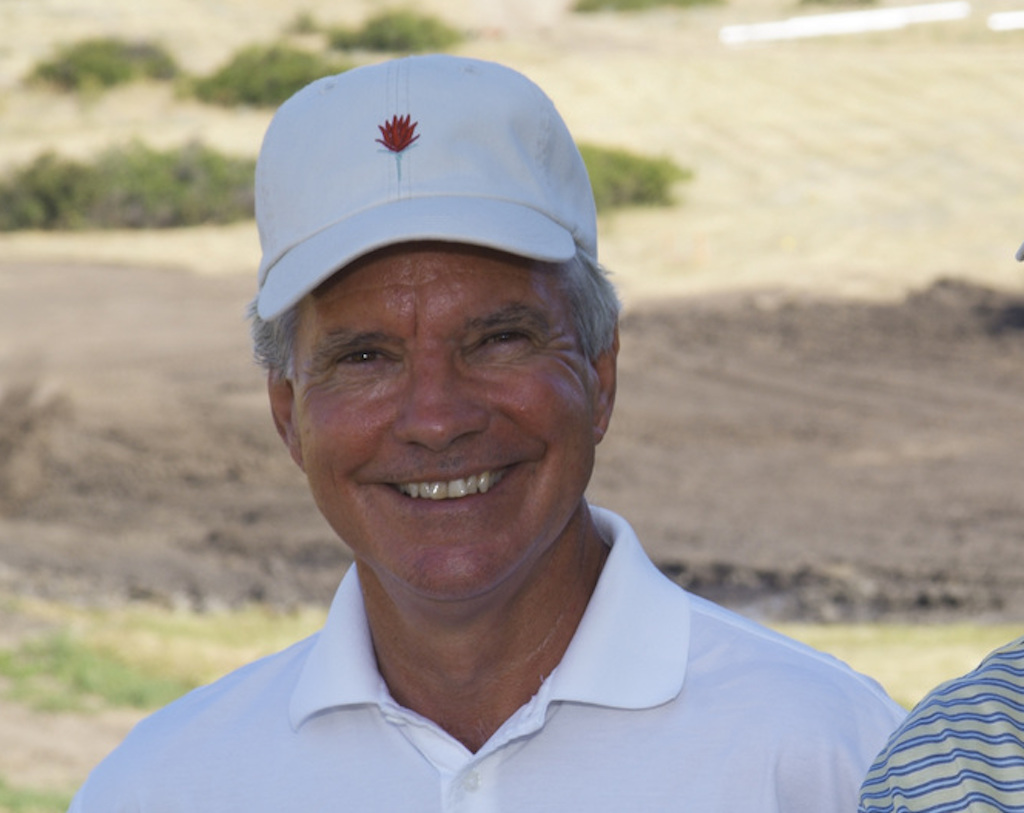
With the impending completion of the final course at Bandon Dunes, the Sheep Ranch, the golf architecture world focuses on the incredible trace that Bill Coore and Ben Crenshaw fit into a piece of land that confounded experts.
It is appropriate to revisit a 2016 interview with Bill Coore on his background in golf and his thoughts on golf course architecture and the game.
The interview is reprinted from our Ronald Montesano’s website, BuffaloGolfer.Com, with permission of the interviewer.
If you’ve never been on a golf trip, I bet you’re tempted to go to Myrtle Beach or someplace like that. If you do, you’ll have fun and you might stumble onto a course designed by Mike Strantz, a terrific designer. If you want to see some great, great golf course architecture, you might end up in Bandon (Oregon) Pinehurst (North Carolina) or Inverness (Nova Scotia), any place you can find a Bill Coore-Ben Crenshaw golf course. Soon you’ll be able to play one at Sand Valley (Wisconsin), and there are many others. Bill Coore spoke to us from a site that he was then assessing, near Charlottesville, Virginia. He SPOKE with us for AN HOUR, as he was mucking through the woods and grasslands of the site. No interview subject has ever given us that much time (over on hour on the phone) and we are humbled.
RM: Tell us about yourself and your history with golf, prior to embarking on your chosen career.
BC: I grew up in rural North Carolina, in Davidson county. I was introduced to golf by my neighbor, Donald Jarrett. He loved to play golf and he would go on weekends and play local public courses in the area. I would caddie for Mr. Jarrett some when I was a kid and he would say, every once in a while “Here, hit one.” He had some old clubs that he let me use and I’d make up some golf holes in his yard or in the corn field, just hitting shots. It wasn’t a formal way, but it was a fun way to be introduced to the game. When I would caddie for him, he would show me the proper way to do things, the rules, etiquette, conduct? I was fortunate in that way. I didn’t grow up in a family with a club membership. I learned what I still think of as proper golf from Mr. Jarrett.
We actually formed a golf team at my high school, my senior year. We talked the baseball coach into letting us play a golf schedule, even though it coincided with the baseball schedule. I went to college at Wake Forest, and played a bit of golf there. And that got the process started, of why do I like this and not that? Why do I like this course? Why do I like Old Town (Winston-Salem, N.C.) so much? I did my own assessment, of why I liked certain courses and not others. I took a serious interest in golf, and from there, a serious interest in golf courses.
RM: How did an interest in golf course architecture lead you to choose a career in the field?
BC: I was fortunate enough, being in North Carolina, which has some very good courses. The Pinehurst courses, in the 1960s, were very affordable, very accessible, particularly in the summer, their off season. Mr. Jarrett would go there once in a while and I would caddie for him, and we would go there once in a while to play golf. I got to experience playing golf there, on Pinehurst #2, and all the other courses there. There is no question that that experience, of being introduced to golf at Pinehurst, and then when I was at Wake Forest, at Old Town Club in Winston-Salem, a Perry Maxwell course, helped me. Pinehurst #2 is basically flat and Old Town is quite hilly, so there were two extremes of land forms and visuals. I just was so fortunate to play those on a regular basis. You don’t appreciate how good they really are, and when you see other courses built or being built, it’s the beginning of an awareness where you gravitate toward a certain style of golf course architecture more than others, and perhaps it was dictated to some degree by my game. I was never a long player, I depended a great deal on short game, finesse, and the ability to run the ball on the ground a lot. And Pinehurst #2, a championship golf course of the highest caliber, would allow you to do that. And a lot of the other, so-called, championship courses, that were already built or being built, just didn’t allow that to happen. I got to the point where I thought, Number two allows me to play my game and it would allow the longest player on tour to play his game, and although we might play from far different spots, we both had the ability to succeed. And that came upon me quite early on. And the man who taught me to play golf, Mr. Jarrett, we were playing our little public course that we had played many times, with a little par three down the hill with a creek that stuck out on a peninsula, with a creek in front, on the right, and behind, and a little hillside to the left. And I would invariably aim at the flag and come up in the creek. (At this point, our phone call dropped, and then my recording app dropped, but the gist was to use the hillside to feed the ball to the green, another revelation for Mr. Coore.) Playing golf at Old Town and at Pinehurst #2 was the foundation for my understanding of what exceptional golf and golf course architecture were all about.
RM: What sort of preparation/training did you do post-college for golf course architecture? Was your undergraduate degree helpful?
BC: My undergraduate degree was in Classical Greek. Most people would likely say I can’t imagine how that could be applicable in any way, but I might disagree somewhat and say, it was helpful because it taught me discipline. Translations of classical Greek in the classroom and preparation for the classroom are quite tedious, very detail oriented, and it takes great patience and attention. I happen to believe that those are attributes that work well in the golf architecture business: attention to detail, patience, and persistence at times. Though it would seem that they don’t have any connection, I would think that the discipline gained, that process, when I was at Wake Forest, was very helpful. I don’t have any technical training. I spent a couple of years in the Army after graduating from Wake Forest. When I was getting ready to get out of the Army, I saw the work that Pete Dye was doing at a public course called Oak Hollow (in High Point, N.C.). It was different, in the Harbor Town mode. It was shorter, it was finesse, it was quirky, with the railroad ties and pot bunkers. It was things you didn’t see and it just fascinated me. I managed to badger Mr. Dye to the point where he just gave up after telling me No so many times. He offered me a job, working as a laborer, and then as an equipment operator on another course he was starting to build in North Carolina, called The Cardinal golf club (in Greensboro.) All my experience and background, my preparation in golf course architecture, doesn’t really relate directly to what I studied in university. It was a process of acknowledging an interest and then starting at the bottom. Mr. and Mrs. Dye were both kind enough to allow that to happen. It was just one of those extraordinary, fortuitous occurrences, just like when Mr. Jarrett took me to play golf, stumbling into Pete Dye building a golf course, not knowing who Pete Dye was. There’s nothing glamorous about any of it, the labor, wearing hip waders, cutting trees three feet deep in water. It was just a process and it all led to today.
RM: How did you and Ben Crenshaw meet, and what led the two of you to believe that a partnership would be both manageable and fruitful?
BC: I had started a design company. I had been given an opportunity to design a course in south Texas with one of the guys who still works with us, in 1980. It was a place with extraordinarily limited funds, so they were desperate enough to give me a chance to work on it. We built nine holes and then skipped a year, and then built the next nine. This takes us to 1984. I had been asked a number of times, You’re designing some golf courses that are pretty good (at this time there were only two) and why don’t you have a partnership with a well-known tour player? It was just not something I had given much thought to, to be perfectly candid. One day, a potential client, also on a site in south Texas, asked me a question: I’d like you to come down and look at another site. It was never going to be a golf course; it was impossible for it to be a golf course. Right along the gulf, it went under water at high tide, and it was salt water at that. The man took it upon himself, in the course of the conversation, he said Why don’t you work with someone? It was 1984 and Ben had just won the Masters, and I had read some articles, and in those articles, it was mentioned several times about his interest in golf course architecture. And I could tell by the comments, that he knew something, that he had studied. When the potential client kept pressing the issue, I said, Well, I guess if it was going to be anyone, it would be Ben Crenshaw. He got in touch with Ben’s business manager and mentioned something about this project. He’s the one who actually got us together. Ben had heard of the golf course we had already done, close by, and he came to look at this other site. The project manager introduced me to him. We never worked on that golf course, of course, and we had no intention of working together, but we started talking about golf architecture over the next year, off and on, and we became friend first. At some point, we said, well, maybe we should try one of these things together. We both felt comfortable enough with each other, both personally and philosophically, regarding golf course architecture. It was no great plan, it wasn’t something that was programmed from the beginning, or something that I had given serious thought to, or something Ben had given serious thought to. Again, it was simply another one of those fortuitous things that happens. That was thirty years ago, and then in December of 1985, we formed our partnership. This past December was the 30th anniversary of our partnership.
RM: Does each of you (Bill Coore and Ben Crenshaw) have easily-defined roles in the partnership? If so, can you tell us what they are?
BC: I think the answer to the first part of the question is No, we don’t have easily-defined roles. There are some things, given the amount of time that we can spend on the site, that gravitate more toward one or the other. The routings, just because I have the freedom of time, over Ben and his playing career, have come a bit more in my domain, but in no way exclusively. Take the Austin Golf Club, for example, it’s totally Ben’s routing. We’ve collaborated on almost all of them, but if you had to say that one of us concentrates on a certain aspect more than the other guy, well, Ben has certainly taught me so much about the details of the land forms that affect the best players in the world and how they think, and how small details can influence the best players in the world. Little slopes here, little contours or hollows there, tilts of the green, angles, the way the wind blows, wind directions. Ben is so extraordinarily perceptive. You could say that if you’re trying to categorize us, it might be those two things, but basically, we overlap. We use each other as sounding boards and we talk to each other about the concepts of the courses, the routings, we go walk them together and make adjustments together. We talk about the concepts of the holes, the bunkering schemes, the greens, and the contouring of the putting surfaces. We bounce ideas off each other, as well as listing them to the guys who work with us, who are extraordinary. In many ways, we’ve both become editors. We do the routing and then we are adamant with the guys that we work with that nothing is set in stone. If something neat begins to happen, go with it. Every one of our guys has the freedom to abandon the original concept at any point, if they think that something better could materialize. In that regard, sometimes, we give a main concept, they work on it, and sometimes you walk back up there and a green complex or a bunker has been roughed in, and you think, well that’s not exactly what we talked about, but it’s better! We’ve always tried to maintain flexibility in the process.
RM: Please describe your process for assessing a piece of land and determining a routing.
BC: When we’re called to look at a piece of land, the first thing we do is go walk the property. We try to get a sense if the land, in its actual state, looks and feels like golf. We try to get a sense of whether you could lay a golf course on that landscape, without huge amounts of alteration to the land forms. If so, we’re very comfortable with that. We’ve done courses where you’ve had to do major alterations, but it’s not our preference. After walking the property (sometimes it can take two or three weeks) if we determine that this property can yield a course to attain the owner’s goals, with us working on it? There are some sites that we have looked at, where someone else could do a great job, but we would spend a lot of money and not do a very good job. We’ve looked at other sites and thought that other architects would be way better at it than we would be. And there are some sites that we look at and say, well, no one could ever do a good job on this. And finally, there are sites you look at and say, this is right in our comfort zone. We try to understand our limitations. The worst thing that can be done is to spend a lot of money and build a bad golf course. The owner needs someone who can sit across the table or stand on the grounds and say, I can do this. I’ve seen some sites where I’ve not known what to do, and Ben hasn’t known what to do, and [another major architect] has built beautiful golf courses on those sites.
RM: You have established a successful working relationship with Mike Keiser. How did that come about and what makes both sides click together?
BC: It was like we won the lottery. Mike Keiser was a founding member at Sand Hills in Nebraska (a course designed by Coore & Crenshaw, recognized as the best new course of the 2nd half of the 20th century), so we had met Mike, but neither one of us really knew Mike. He called me on the phone and he said Bill, I’d like to talk to you and Ben about doing the third course at Bandon. I’m going to be very candid with you: it’s not on the ocean, a lot of it’s going to be interior, back in the woods, most people will probably perceive it as an inferior piece of property to what Bandon Dunes and Pacific Dunes are on. We had seen what he had done out there with David Kidd (the original Bandon Dunes course), with Tom Doak and Jim Urbina (the Pacific Dunes course) and it was fantastic. We wanted to look at the site at the very least. We went out and looked at it and the results of studying it for a fairly long time, and after various conversations about where the golf course should be, it ended up being Bandon Trails. We knew that it had some difficult spots; there is a big ridge that runs through it that we had to work around.
Ben and I felt that All we want to do here is build a golf course that complements the other two somehow. We don’t want to build a golf course that nobody wants to play, but we think we can do something hopefully good enough that people will appreciate it. He gave us the chance to do that and in that process, he became not only an extraordinary client, but a very, very good friend. Mike Keiser has incredible insight from the standpoint of, as he calls it, the retail golfer, what the paying customer looks for, and the experience they hope to have, as well as an affection for seaside or sand-based golf. We got to work at Bandon Trails, Lost Farm at Barnbougle Dunes (Tasmania) and then more recently, up at Cabot Cliffs in Nova Scotia, and last the par-three course, the Preserve at Bandon, so Mike has been so generous to us, that I would never know how to thank him. He has given us opportunities that anyone in this profession would be thrilled for. In my mind, he is the patron saint of modern-day architecture. He affords people in our business opportunities that we could have never dreamed of, spectacular sites to work with, and the freedom to work with them. I’ve enjoyed every walkabout, whether it’s to assess a new property or a course under construction, like the first course at Sand Valley, in Wisconsin (designed by Coore and Crenshaw, that will open for play in 2017.)
RM: Give us a sense of where you see golf course architecture heading in the next 25 years, and what you hope your firm’s role will be.
BC: We hope that golf architecture evolves in a fashion that maintains people’s interest in the game. That may be in the form of shorter courses, courses with less than 18 holes. I grew up on a nine-hole course and most of the public courses around me were nine-hole courses. Certainly, Ben and I are not dismissive of courses with less than 18 holes, or of shorter courses. If there are ways to make golf more accessible and more enjoyable for people, that’s fantastic. You only have to look at the two, non-18 hole courses at Bandon, to understand this. The one we did, the Preserve, is absolutely chock full of people, all the time, playing it over and over. It’s tremendous fun. It doesn’t require excessive strength or excessive skill to enjoy. The Punch Bowl, which Tom Doak did out there, is a giant putting course. Now, do you call that a golf course? Well, I guess it depends on your definition, but you could certainly spend all day out there, or an hour. That’s just as much golf as any of the big courses at Bandon. Those are just two examples of things that could happen. The world is so fast-paced, and families have so much going on, that it’s almost unreasonable to ask people to go spend the entire day at a golf course. Any type of golf course architecture that provides interesting golf and which can be experienced in a shorter period of time, be it three hours or an hour, is the way that golf out to go.
RM: What question haven’t we (or anyone) asked, that you would love to answer? Ask it and answer it, please. This was a challenge for me and Bill. It ended up being more of an idea than a question, and here it is:
BC: Any question that would allow us to express how talented the guys who work with us are.
I said earlier that Ben and I often fulfill the role of editors rather than authors. The fellows that work with us are so often referred to as shapers or bulldozer operators; they are that but so much more. There are several of them that have done their own designs. Dave Axland and Dan Proctor did Wild Horse (Nebraska.) Dave Zinkand who worked with us for twelve years, has redesigned Desert Forest (Arizona.) These fellows have all done their own designs, and yet they come out and work with us on equipment, help us build bunkers. Rod Whitman, the Canadian architect, has three or four of the top ten courses in Canada. He has worked on greens, bunkers, fairways and tees on our golf courses for years. Our list of about ten guys who are so extraordinarily talented, there’s not one of them who could not go out on his own, if circumstances presented themselves, and design one heck of a golf course, that we would all be proud of. They are just extraordinary: Jimbo Wright, Jeff Craig, Jeff Bradley, the premier bunker guy in America. It’s fun to see them, to see the talent, and to be a part of it.
- LIKE16
- LEGIT1
- WOW2
- LOL0
- IDHT0
- FLOP0
- OB0
- SHANK1
Courses
The Scottsdale Experience, Part II: Boulders, Troon North, and Camelback

It’s been four years since my last desert golf trip in Arizona. For an area so rich in good golf, that’s too long to wait for a return trip.
Our last visit to Scottsdale brought my family to the Fairmont Princess during the Christmas season. We just like to visit this time of year because everything is decorated for the holidays. While there, I was able to play at TPC Scottsdale, Grayhawk, and We Ko Pa–all stunning tracks for every handicap level.
For this trip, now four years removed, we wanted to experience two different types of Scottsdale resorts: The first two nights at Boulders Resort and Spa, about 30 minutes north of town, surrounded by (you guessed it) boulders and nature. For the second two nights, my wife wanted to be a bit closer to the city life so we picked the JW Marriott Camelback Inn, minutes from Old Town Scottsdale.
There are many differences between the two resorts, but both somehow maintained the vibe of being in the Valley.
BOULDERS RESORT AND SPA
The Boulders Resort and Spa sprawls out across an enormous piece of property, which includes two award-winning, Jay Morrish-designed golf courses that both rank well as playable golf courses in the state. When you check in, they give you a map and a flashlight to help you navigate the grounds at night. The rooms (or casitas) are villa-esque, complete with your own fireplace and wood to burn on cold nights. The place just smells like fresh air and chimineas.
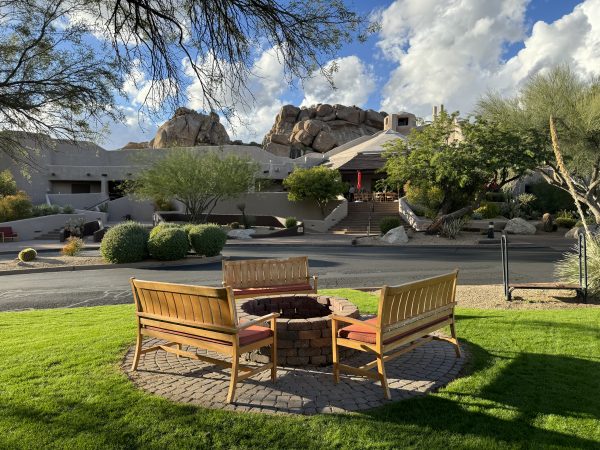
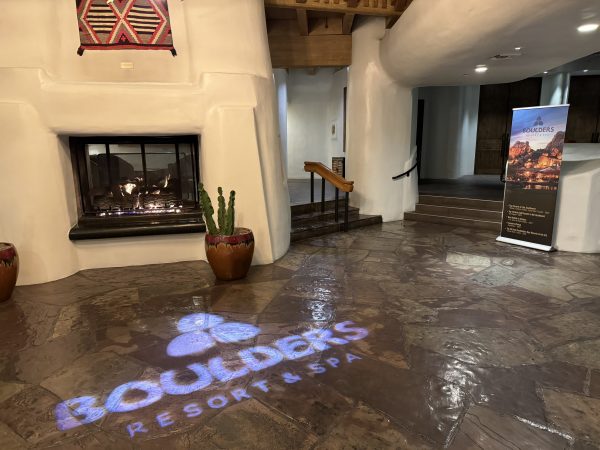
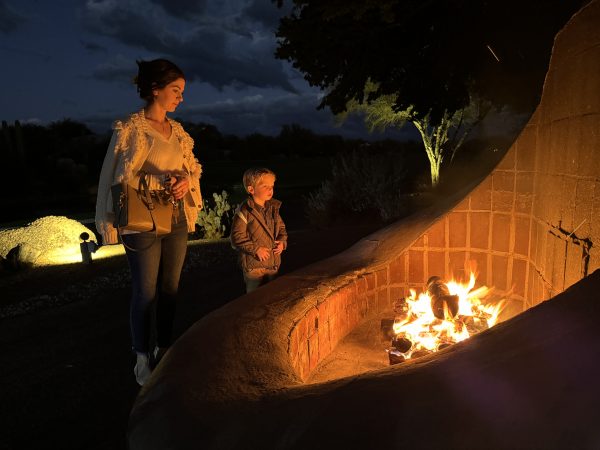
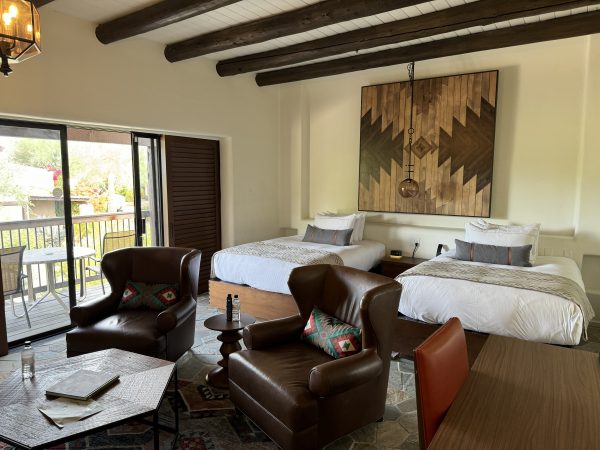
The lodge itself is nestled beneath a small mountain with accessible hiking trails along both sides. Behind the main lobby sits a good-sized pool, which was heated when we visited and allowed for swimming in November. Temperatures this time of year are typically pretty chilly, especially for early morning golf, so to be able to swim in warm water was a nice treat.
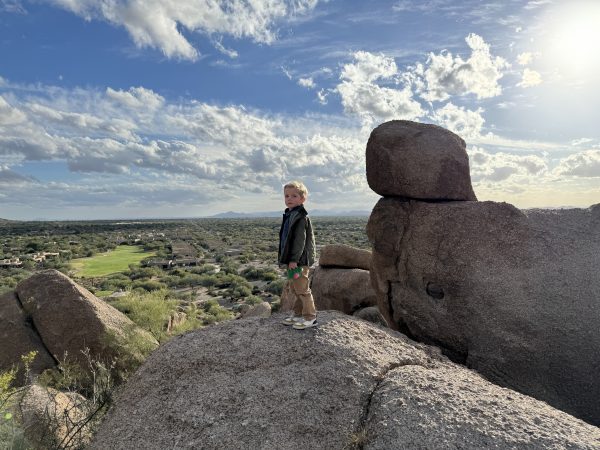
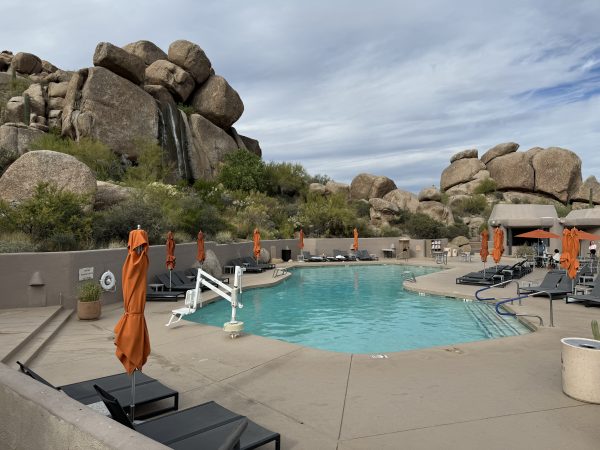
The two courses are both on the property, making Boulders Resort a truly ‘never have to leave’ type of resort. There are also multiple restaurants on-site, including Bogey’s Bar near the pro shop and 18th greens for both courses. Boulders is home to about 400 golfing membership families but also remains open for public play as well. The members and public alternate courses each day, which apparently works great and keeps a high-season traffic light on both courses. I played the North Course but also walked the South to get a good feel for each.
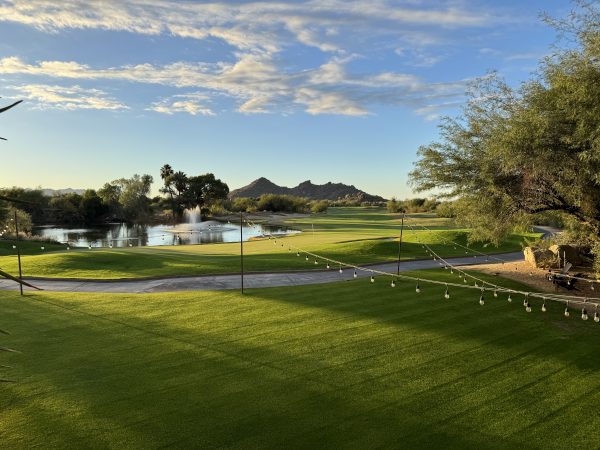
View from clubhouse over 18 of South Course
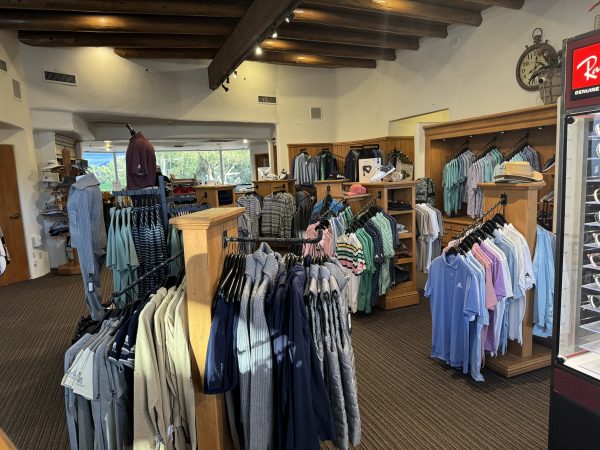
Boulders Pro Shop
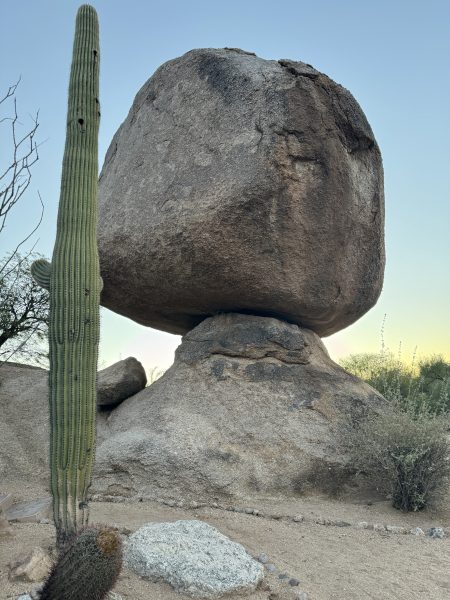
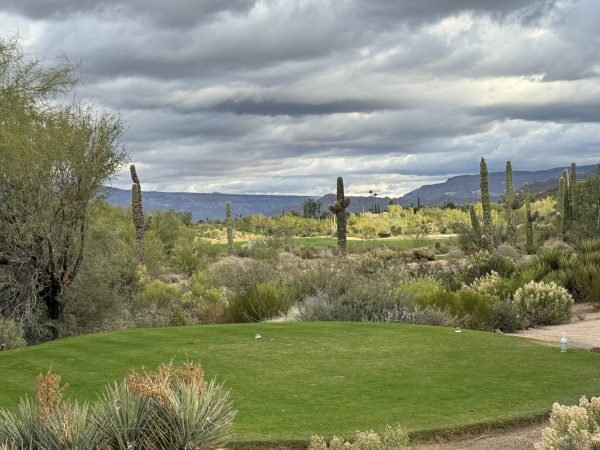
Number one tee- Boulders North
The North course tips out at 6,959 yards but can play as short as 4900 from the red tees. There are six tee box options in total, which helps on a desert course like this because between the frequently watered green grass come many different varieties of wasteland carries and sandy ravines. With options on tees and course length, many of the challenging shots can be added or taken out depending on skill level.
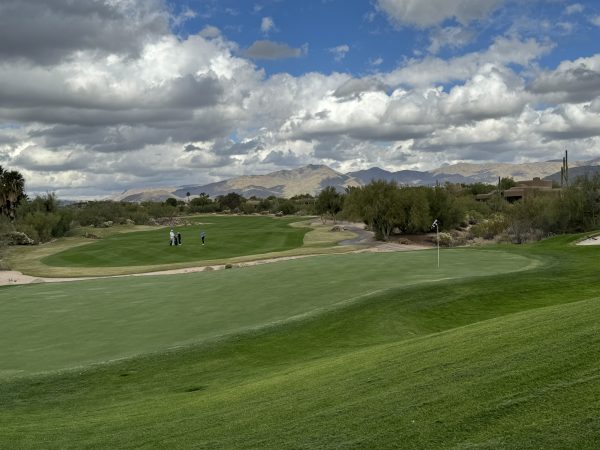
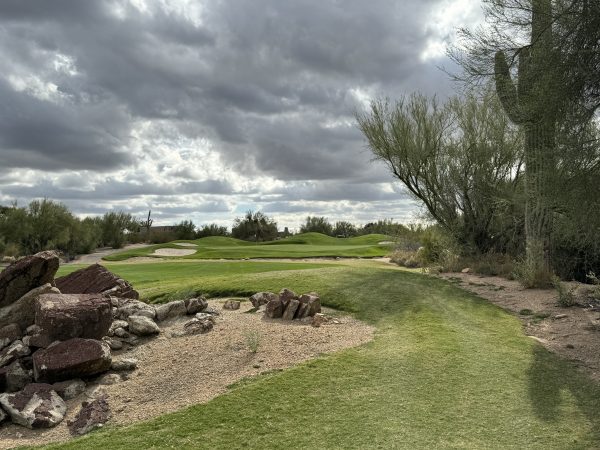
You can expect a lot of uneven lies at Boulders, as most of the fairways and playing surfaces undulate to blend right in with the surrounding mountains. Saguaro cacti are in every site line, but the predominant feature of both courses is the elephant-sized boulders on nearly every hole. Some appear to teter on their end, ready to roll down into the bunker where your ball is resting.
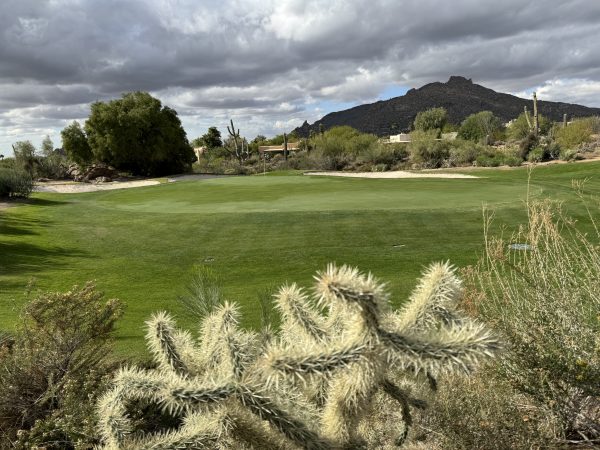
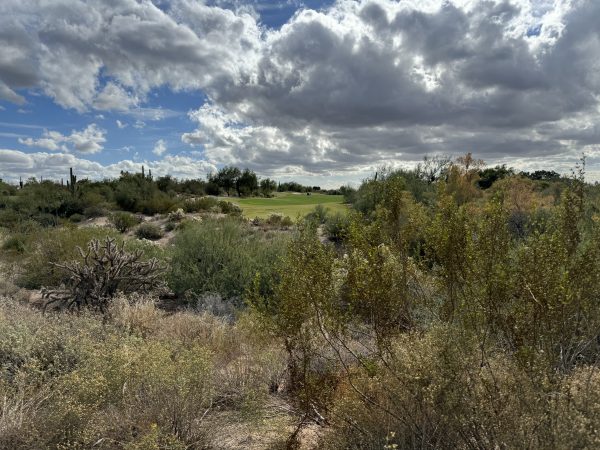
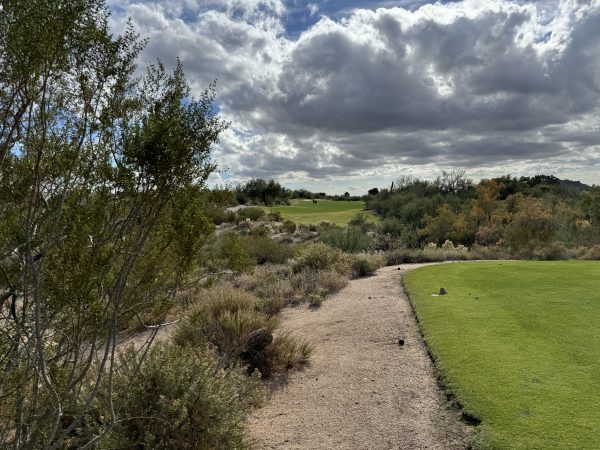
Of course, like most desert-style courses, errant shots are findable in the sandy soil, but not without risk of being pricked, poked, or bitten. My general rule is that if I can’t see it from the green grass, I’m better off not wandering too far out in search of what might be painful to find. Drop a ball and take my medicine. That proved to be true at Boulders as well. There are many thick areas just off the fairway where man should not be. And a better golfer than myself would only look in that direction to view the beauty of the Sonoran Desert.
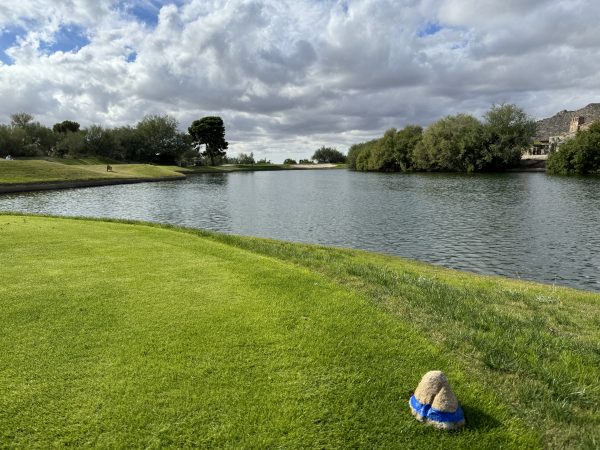
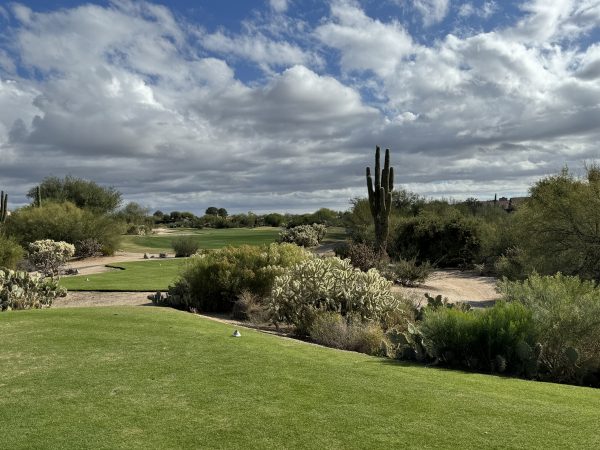
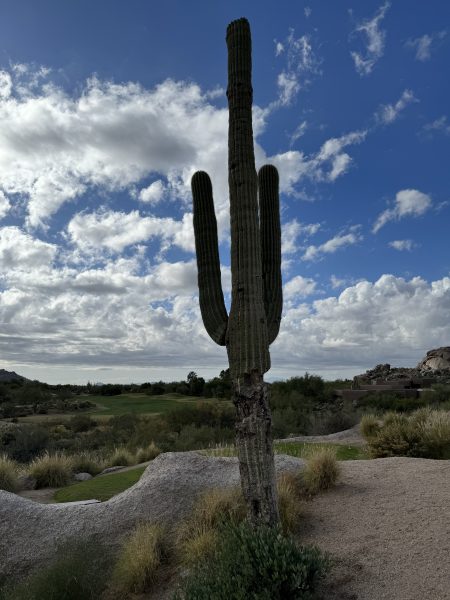
Both courses do have a few splatters of water hazards here and there. Most folks I spoke to on the property noted that the South Course has a couple more breathtaking views and elevation changes than its counterpart North, but the North Course provides a wider array of shot-making options for the more serious golfer. I thought both courses were stunning to the eye, but it wouldn’t shock me if, had I played South, I found it a bit easier and more resort-style friendly.
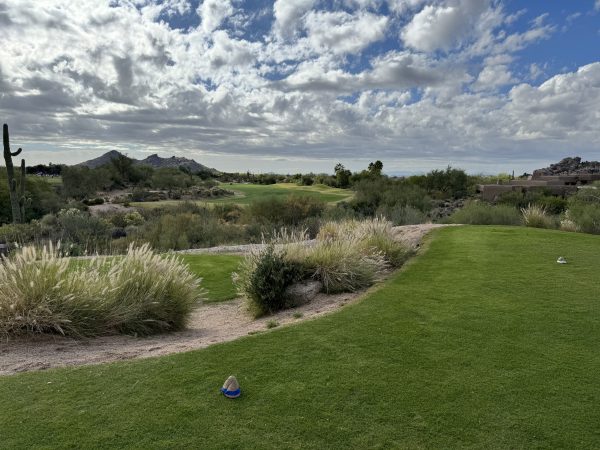

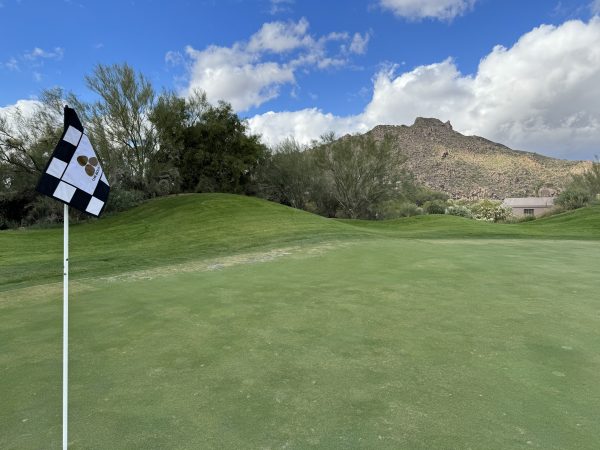
Non-member tee times can be booked online or through the pro shop but if you are staying at the lodge, you’re more than likely going to get a better hotel rate to play. In November, which is almost peak season, mid-week greens fees range from around $100-$200 with dynamic pricing throughout the day. Both courses are incredibly walkable and a caddie or pushcart can be available upon request.
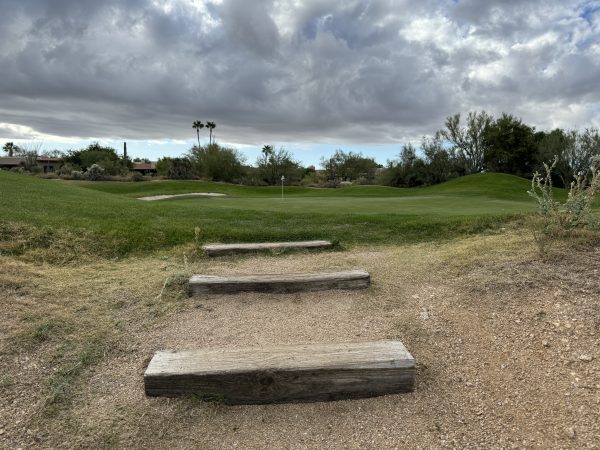
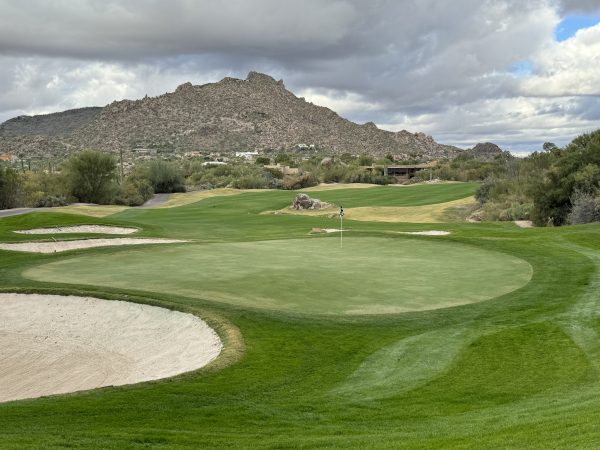
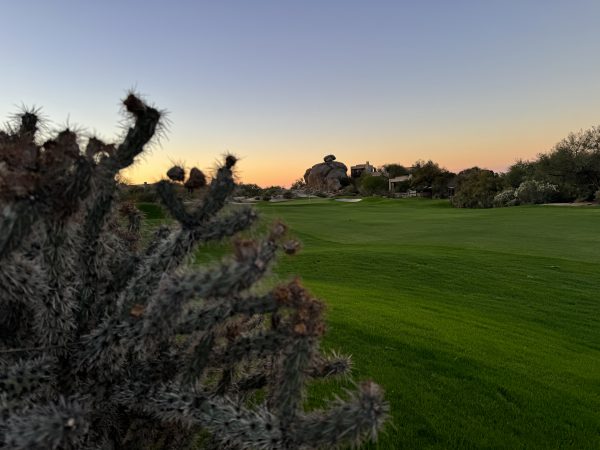
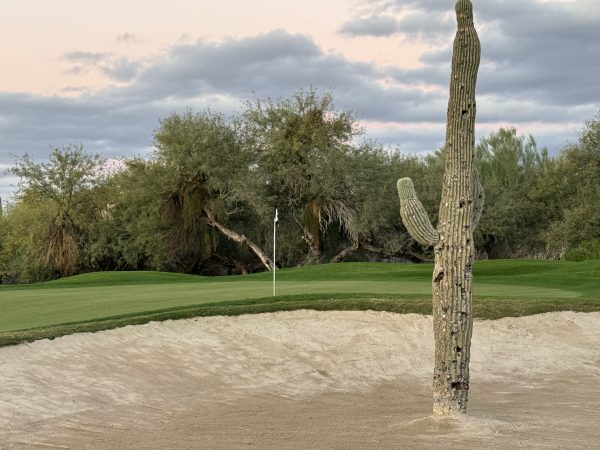
After my round, I took my son on a hike up the mountain above the lodge for some pretty stunning views of both courses. My wife escaped to the spa for a 90-minute hot stone massage, which was my way of saying thank you for another golf trip for the family. The least I could do. She said it was incredible and unlike any other massage she has ever had in her life. They even put hot stones between her toes, which I suppose feels good.
We wrapped up our stay at Boulders with a fantastic dinner at Palo Verde, located at the resort headquarters. We were able to sit outside under the stars with the help of a few closely placed heaters. With the golf, the restaurants, and the natural activities available, Boulders proved to be a wonderful spot to relax and get some swings in. If your partner is a fan of spa days and calm settings, this is the golf resort in Scottsdale to stay at. The food, drinks, and lodging are all upscale. I would say it is a perfect couples’ getaway resort. We didn’t see any other kids so there may be better places to stay if you’re bringing the little ones along, though. With kids, I’d stay closer to town (see below) and head up to Boulders for a round of golf only.
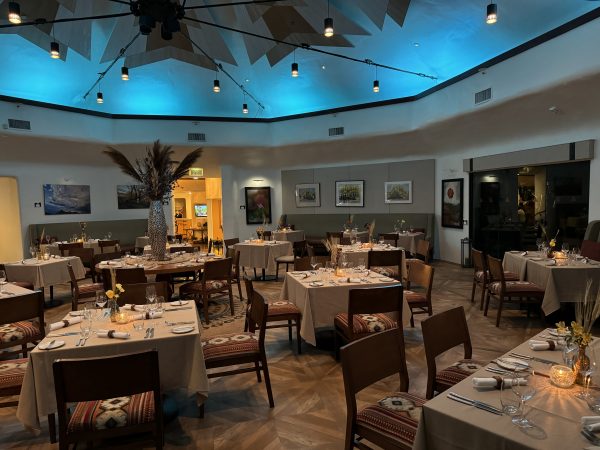
Palo Verde dining room at Boulders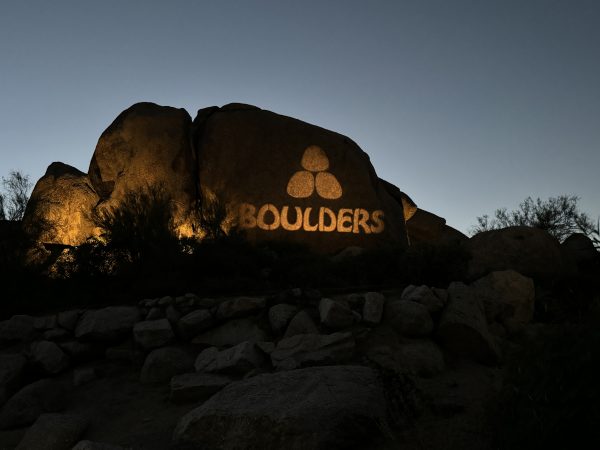
TROON NORTH
The next morning, I took an Uber just a few minutes away to the Troon North campus for a round at the Pinnacle Course. Troon North is home to two tracks, both designed by Tom Weiskopf and both immaculately maintained year round. The Pinnacle course is more links-style than its sister, the Monument Course, which is widely considered the signature course between the two.
The clubhouse is first class, with a well-stocked 2,200 square foot pro shop, and a legitimate locker room for public use. And the logo is fantastic.
Troon North offers a membership plan as well as public play, and daily fees are dynamicly priced.
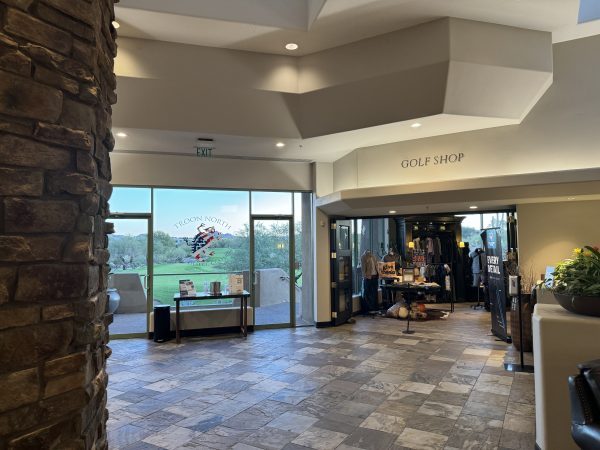
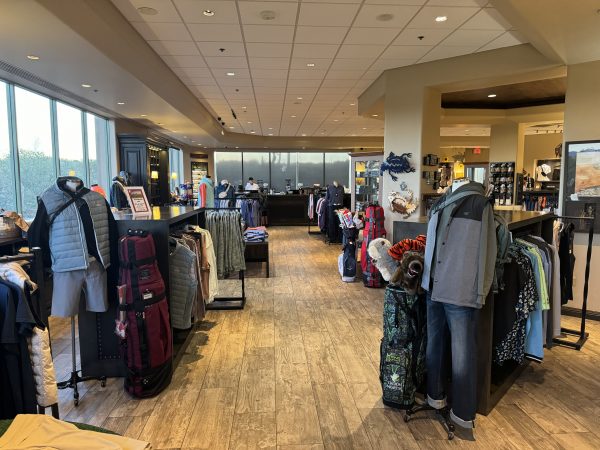
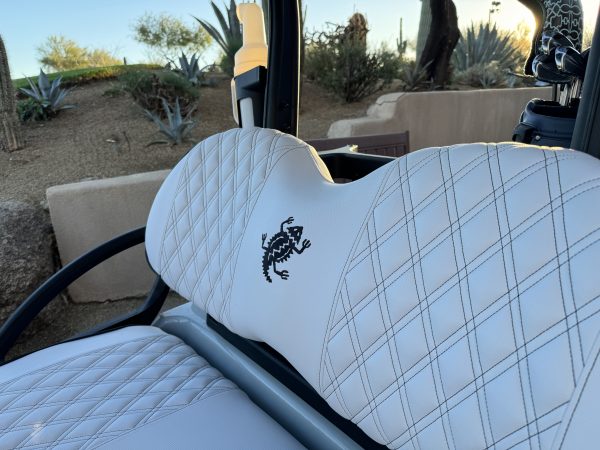
Pinnacle course plays over 7,000 yards from the back tees but provides seven different tee boxes allowing you to play the course as short as 4831 yards. Though more links style than Monument, the course still provides a very Sonoran desert feel and carries over thorny brush on nearly every hole.
Both courses were ranked in the “Top 10” best courses you can play in Arizona by Golfweek.
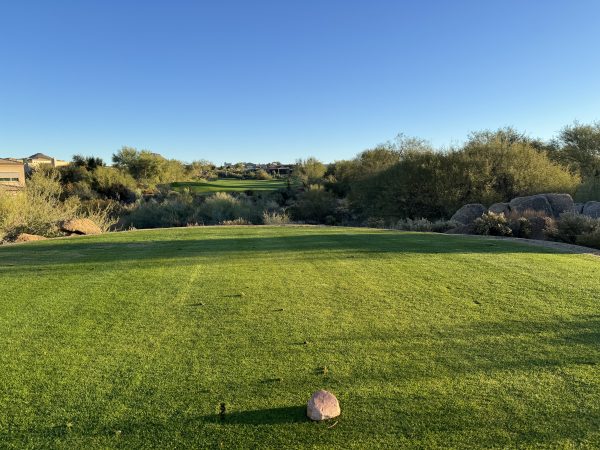
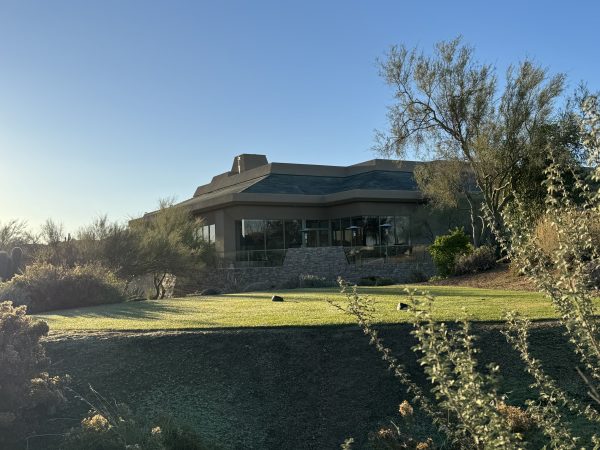

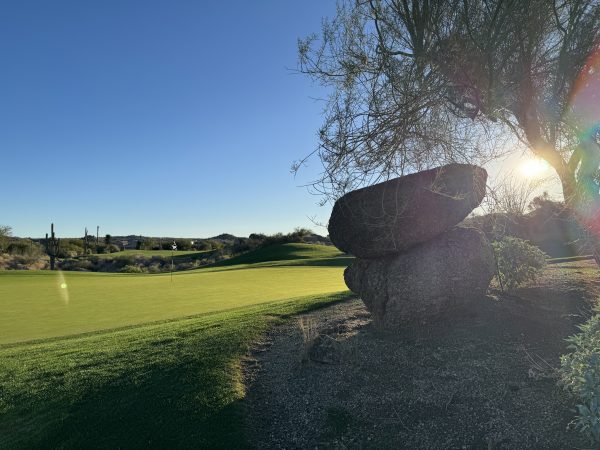
I thoroughly enjoyed my round at Troon North. The facility is about 35 minutes north of the Phoenix airport so it’s a bit closer to downtown Scottsdale than Boulders. It is also closely connected to the Four Seasons should you be looking to stay nearby.
The course felt pristine and special. You can tell the place pays attention to detail and takes great pride in the condition of the courses. The layout has some elevation changes so it may not be the easiest to walk. The routing never really brings you back to the clubhouse until the 18th hole, either, but there is a comfort station out there and beverage carts making the rounds.
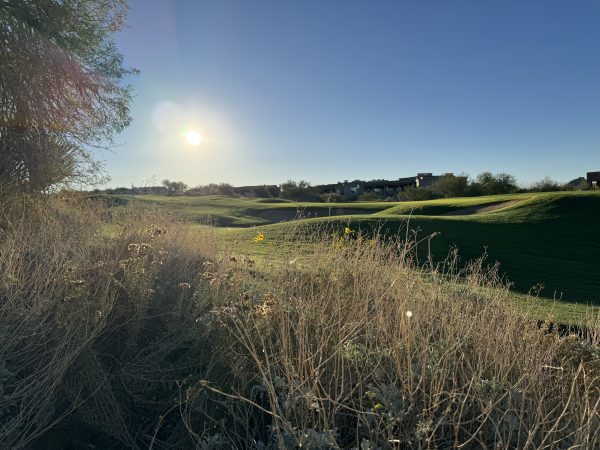
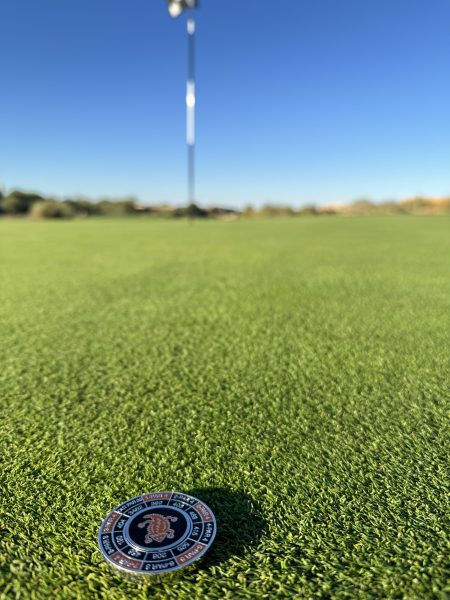
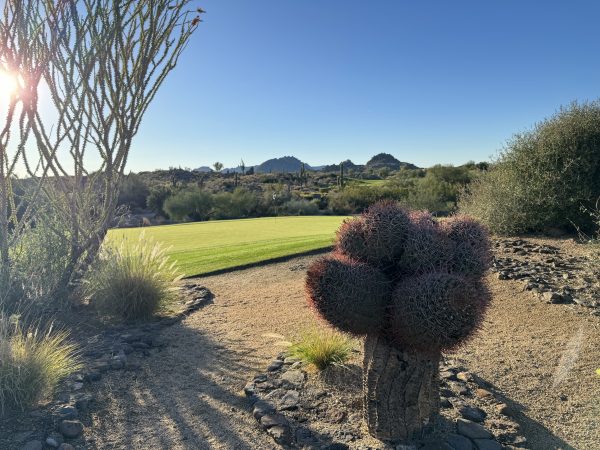
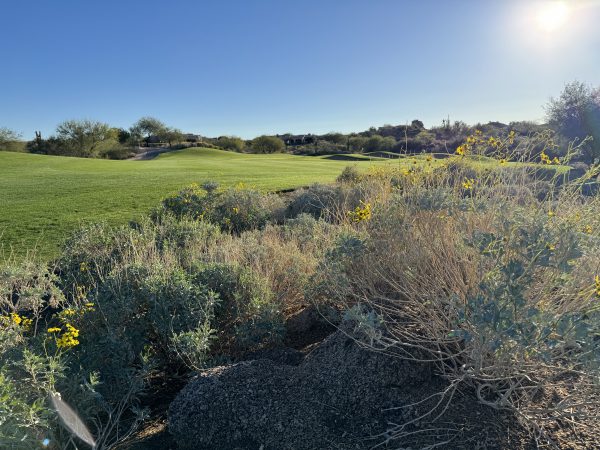
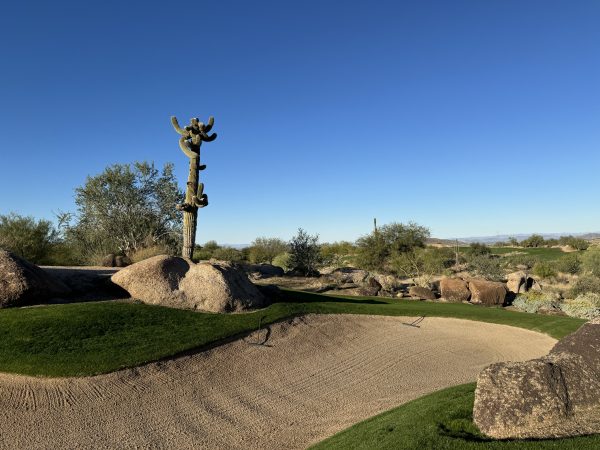
The bunkering is fair and not very deep, but they are strategically placed right where you don’t want them to be. The par 71 has only one par 5 on the front nine but boasts a 609-yarder on the back that plays every bit as long as it reads. The par threes are scenic but lengthy as well, generally playing around 200 yards from the backs except for the short 140-yard 16th.
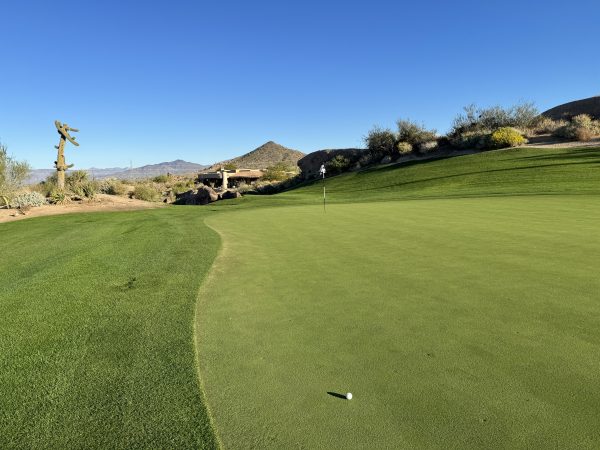
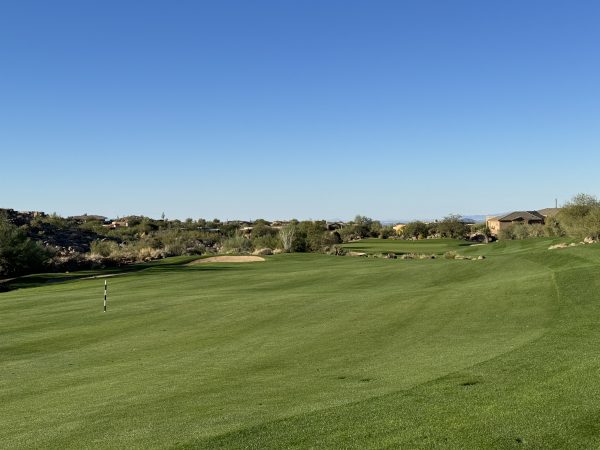
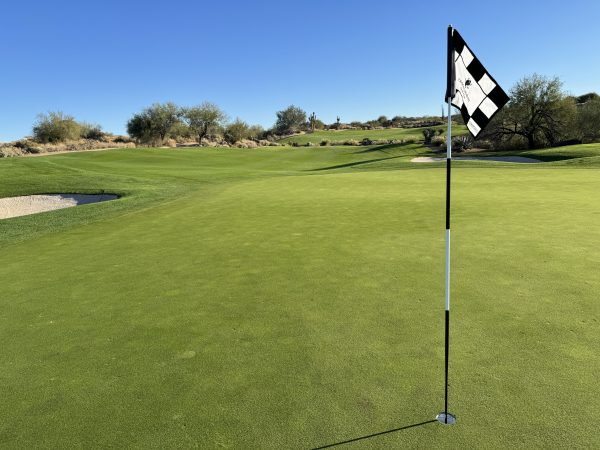
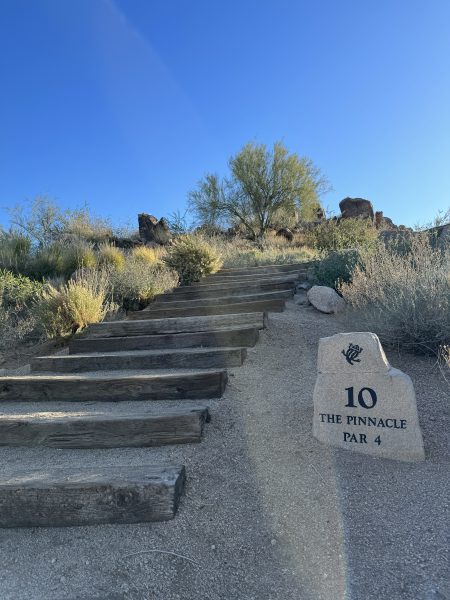
The fairways are bermuda grass and the greens are bent. Overseeding is done in the fall but the schedule is posted online to help avoid any unpleasant rounds. There are valley quail all over the course that walk in front of you on fairways and tee boxes like schools of fish.
The course is just so scenic and first-class. The mountains are in view the entire time and the course provides a wide array of options and shotmaking opportunities. I played early and alone and I genuinely enjoyed my time on the course. It was my favorite round of the trip.
The 18th green is huge and it blends into the practice green near the clubhouse, snaking around a giant rock to protect the practice green from shots gone long. It is a very unique site from both the clubhouse and the 18th hole but adds some character to the facility.

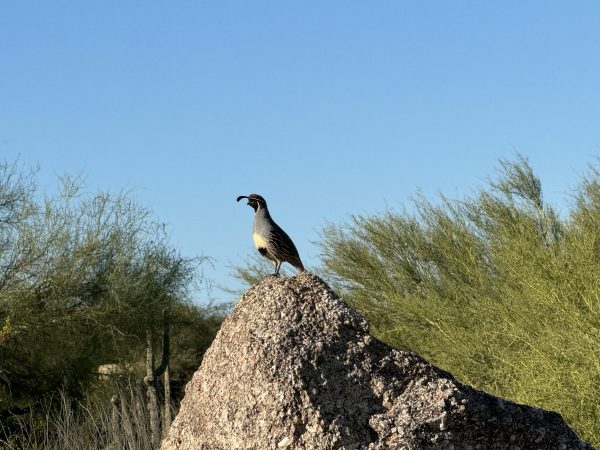
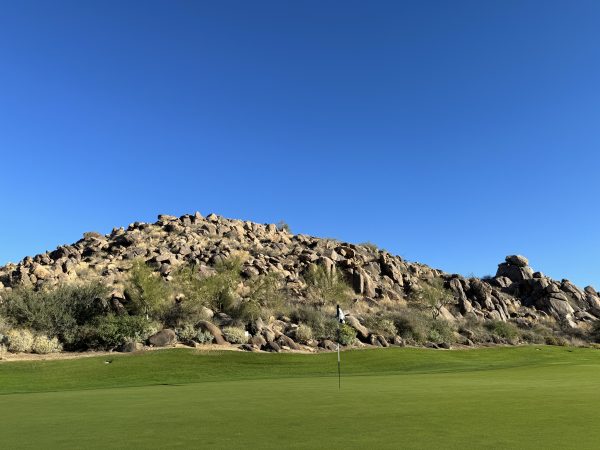

CAMELBACK INN RESORT AND GOLF
The JW Marriott Camelback Inn is an incredible hotel. I am not really sure how else to describe it. Being there feels the way an in-city Scottsdale hotel is supposed to feel. You’re surrounded by Camelback mountain on one side and Mummy Mountain on the other. The adobe buildings feel like they have been there forever and yet are still perfectly maintained. There are sitting areas near fireplaces around every turn and the landscaping is quintessentially desert floral.
We heard from more than one person that the Camelback Inn is Mr. Marriott’s favorite hotel within his entire company and he spends one month there every year. That is saying something!
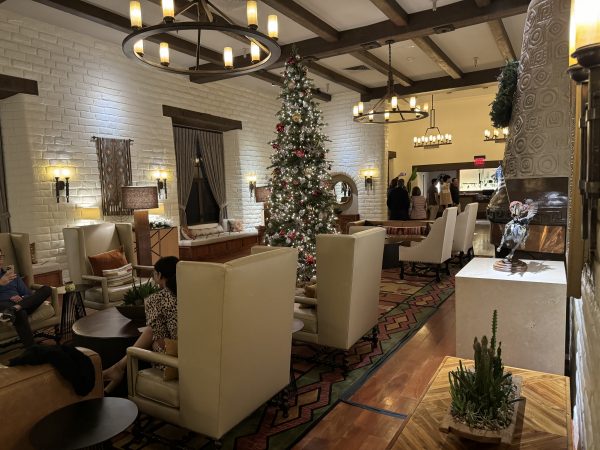
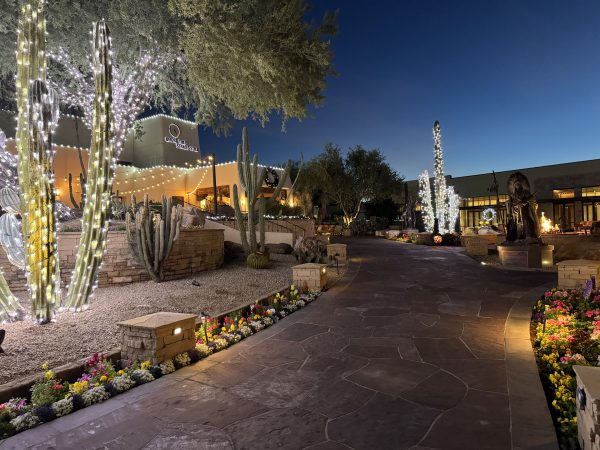
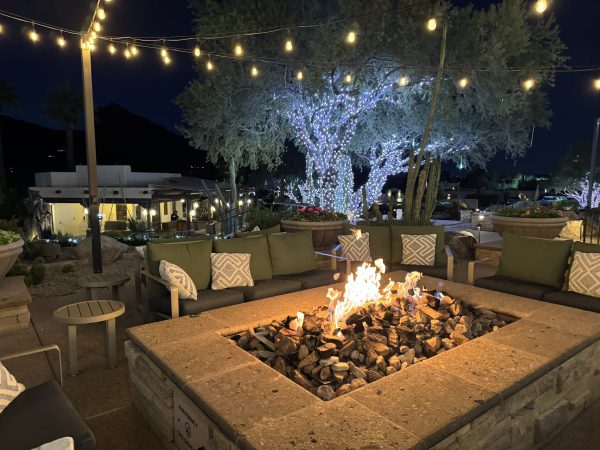
Our room was standard size but wonderfully located just a hundred yards or so away from the main lodge and restaurants. Between us was a green space with lawn activities for guests of all ages. There is a playground and putting green on site and several pools (some heated) for swimming year-round. And the views are just spectacular. To be only minutes away from Old Town while still being able to hike up multiple mountains of your choosing is one of the most special things about Scottsdale.
We ate breakfast, lunch, and dinner at Rita’s Cantina and Bar…simply because the menus change for each meal and the outside patio seating is so incredible. Hoppin’ Jacks at the pool is another dining option but the Lincoln Steakhouse and Bar is the upscale dinner spot…and the gem of the dining options.
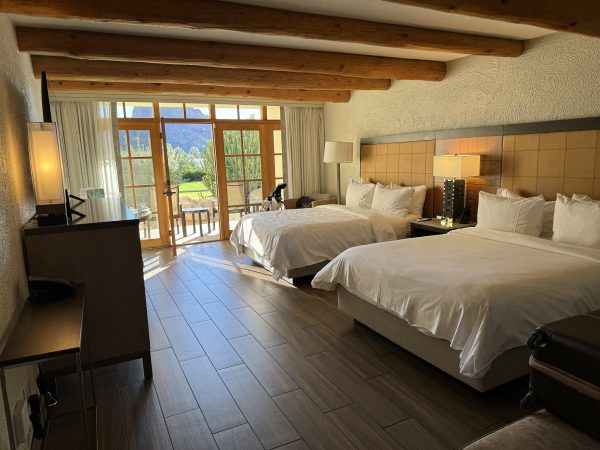
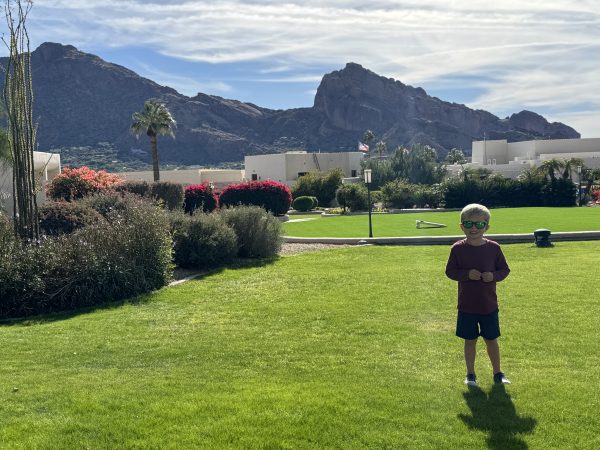
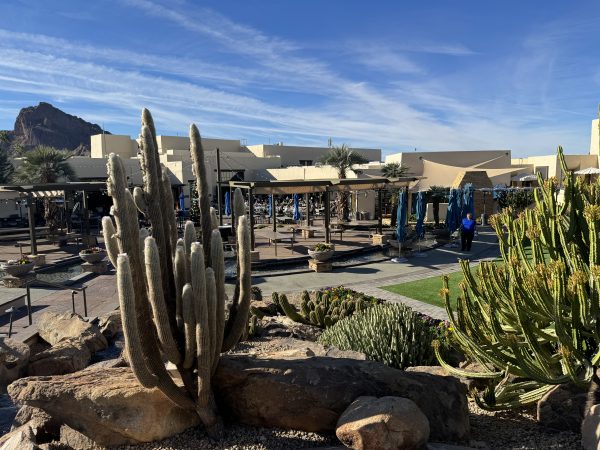
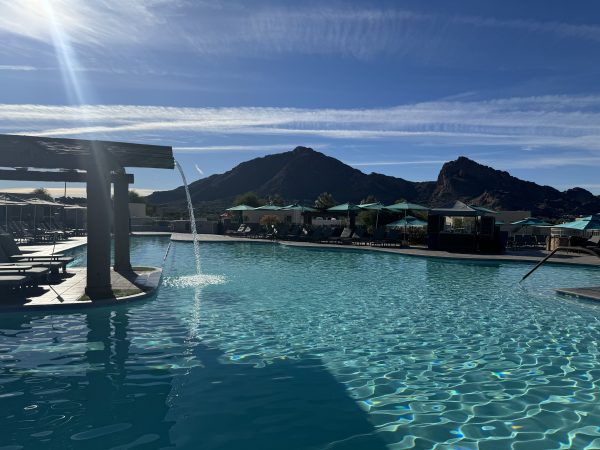
The Camelback Golf Courses, Ambiente, and Padre, are not on site, but the resort provides you with a free shuttle service for your tee time. The ride is only about five minutes and they start at 7:00 am.
The clubhouse is large with a spacious golf shop. The Camelback logo, while a bit cartoony, is pretty fantastic in a 1960s Bob Hope Classic kind of way.

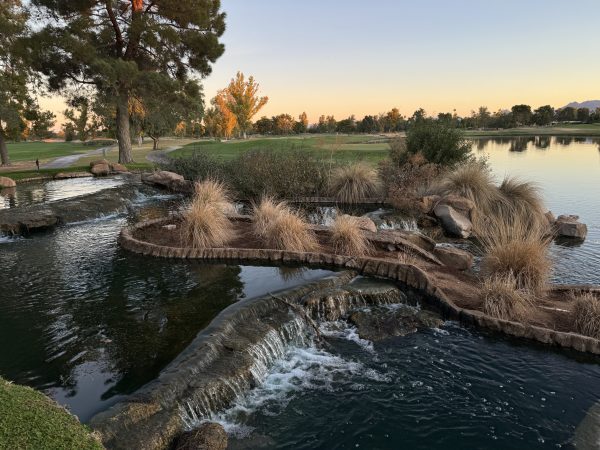

I played the Ambiente course, which I was told has a bit more character than the Padre. Ambiente goes straight out for 3 miles, following along a gulch on your right the whole way, and then turns around and comes right back to the clubhouse for the back nine. If you are walking, make sure you’re in it for an entire 18-hole round. There’s no stopping after nine if you are on foot and three miles away from the clubhouse.
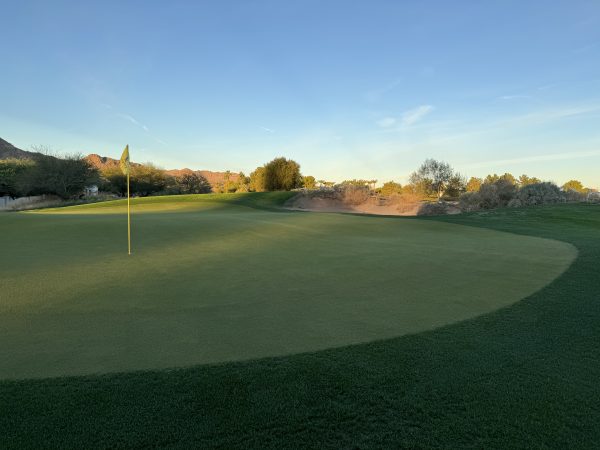
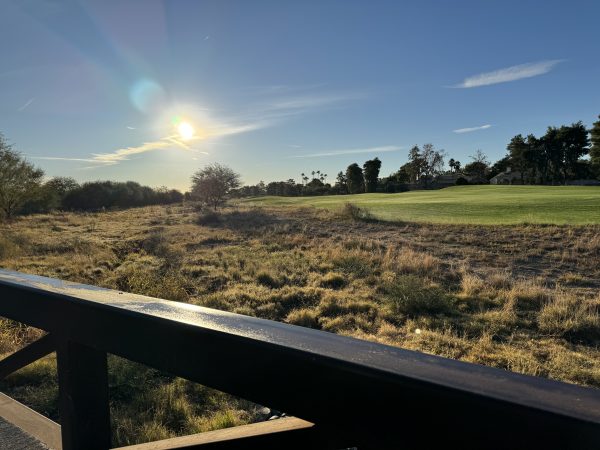
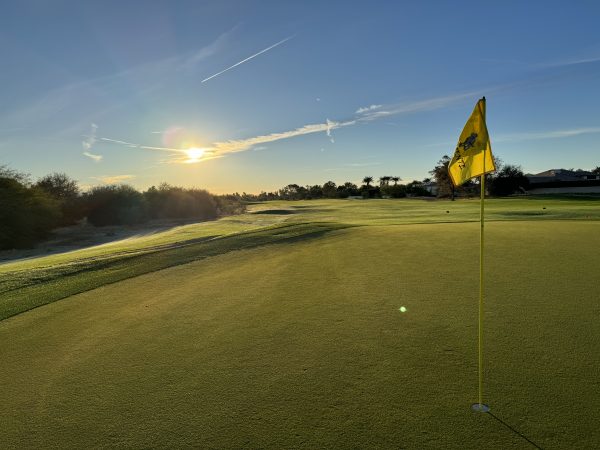
These courses are more parkland than desert. That’s especially true of the Padre course. But even Ambiente, which translates to ‘environment,’ is not very ‘deserty’ in comparison to Troon North or Boulders. There are a lot more grassy rough areas off the fairway and very little cactus. The gulch, which is seen on nearly every hole, feels more native and marshy than anything I saw in my previous rounds. It’s a gorgeous course, but not what you imagine when you think of Scottsdale golf.
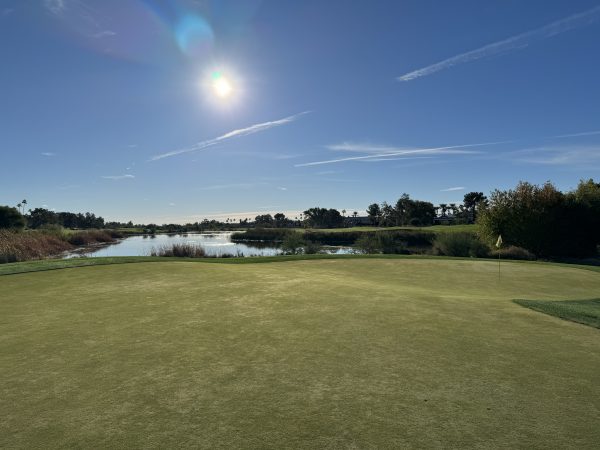

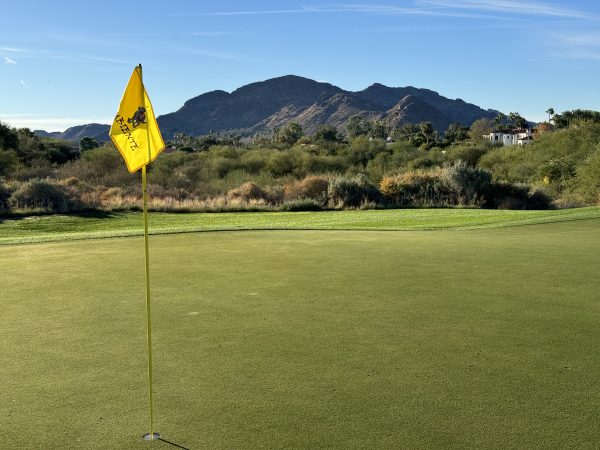
The course itself, with its unique straight-out, straight-back routing, lengthens out to 7,225 yards from the tips and 5,538 from the forward tees. The par 72 Jason Straka design is not an easy course. Many of the holes require precision tee shots and a bit of course knowledge doesn’t hurt as the driver is not always proper. The par threes play long, with the shortest being 185 from the back tees. The 8th hole can stretch back to 241 yards and then number 15 goes even longer to 245. Of course, you don’t have to hit back there unless you’re a glutton for punishment.
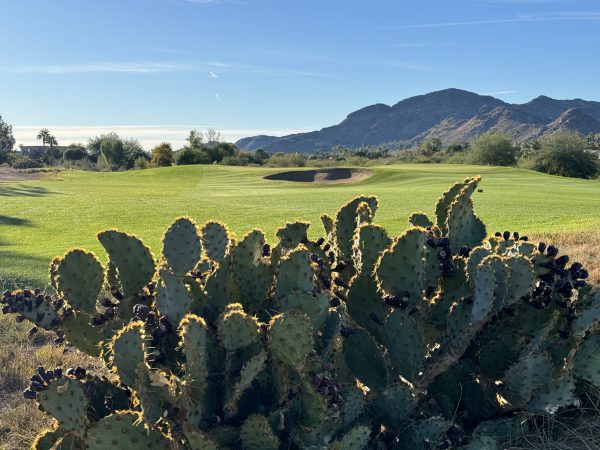
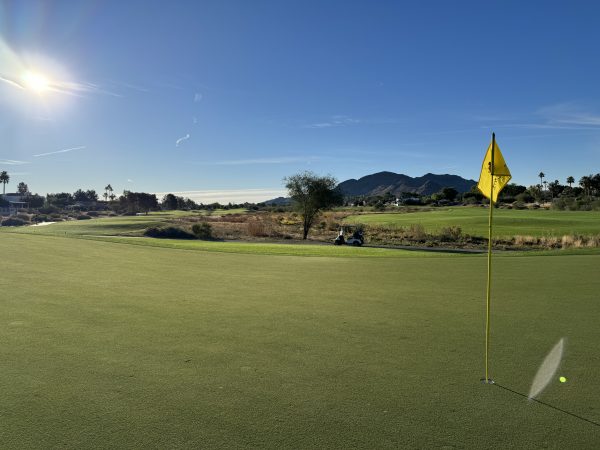
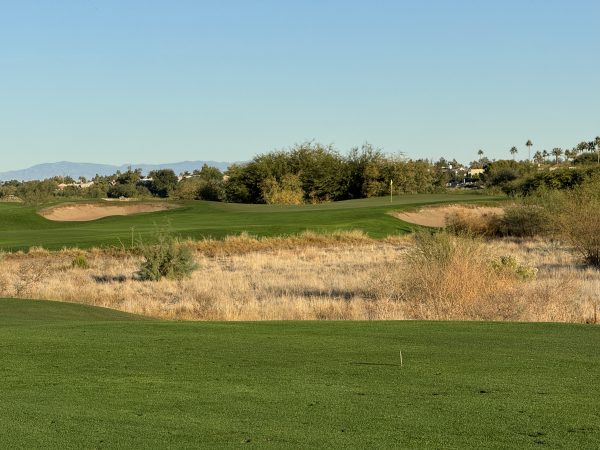
The bunkering is deep in certain areas, which you realize as early as the greenside on the first hole. Playing this course after the other desert layouts I have played made me wonder if this is the true ‘nature’ of the area and perhaps the other desert courses are a bit more…manufactured. Ambiente feels native. I think I enjoy the other desert style aesthetics of the other courses more, but from a pure golf perspective, Ambiente at Camelback is a real deal course.

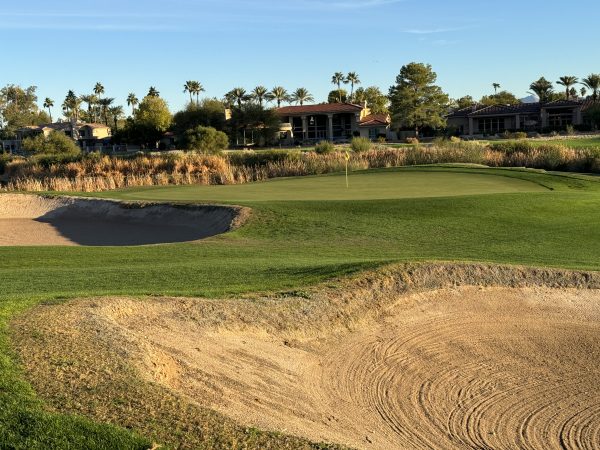
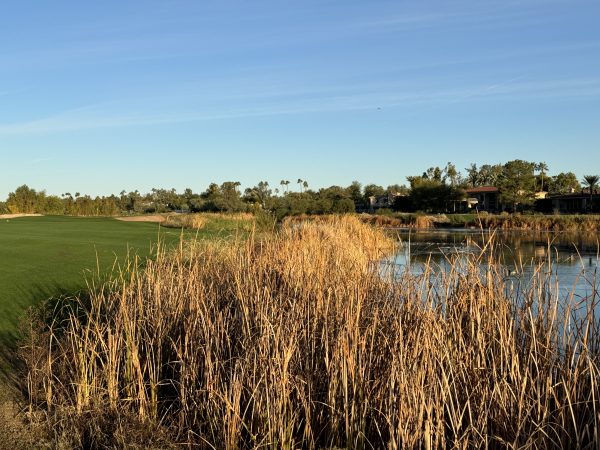
SCOTTSDALE LIFE
The beauty of Scottsdale as a golf destination is that no matter which courses or resorts you decide to enjoy, you are still always within 30 minutes of a fantastic city center, with great shops and world-class restaurants. Old Town is only one little pocket of what Scottsdale has to offer, but because of the neat stores for our kiddo and walkability, we spent most of our time away from the resort here.
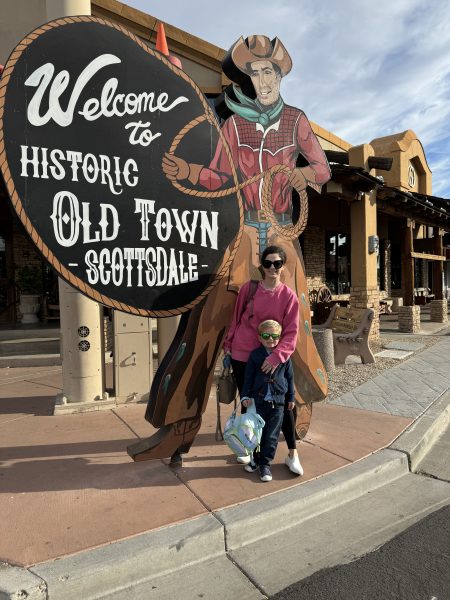
Like any great city, anyone who has visited will be able to give you a list of their favorite places to play, shop, and eat. For us, we loved going to Popstroke, the Tiger Woods-designed miniature golf course, as well as Mavrix for bowling and laser tag. When you’ve got a five-year-old, you do what makes him happy too. We also went to Isabella’s Kitchen for lunch on one of our days, which overlooks the McDowell Mountains and Grayhawk Golf Course. The food is always delicious and it’s a really fun location for the kiddo to run around while mom and dad can have a margarita.
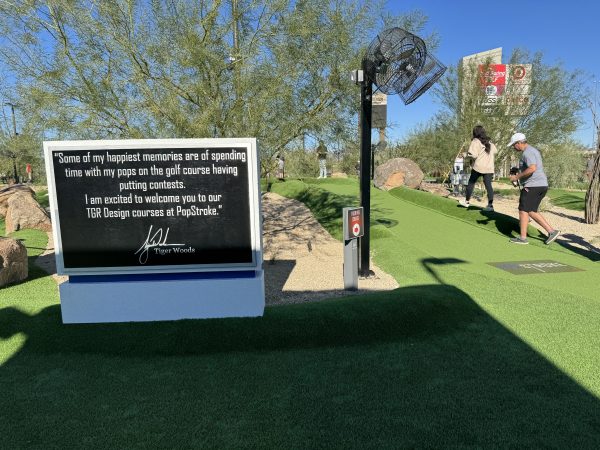
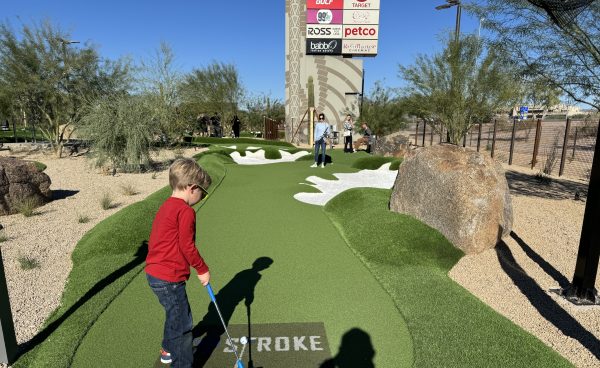
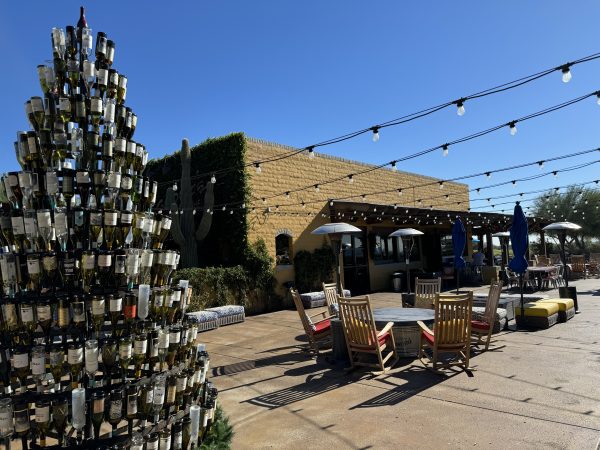
We went to The Montauk in Old Town for our only dinner outside of the resort and it did not disappoint. It’s a really neat atmosphere and the menu was a mix between The Hamptons and Southwest tastings. They had live music and friendly staff. It doesn’t get much better.
And if you find yourself out and about for breakfast, you need to stop in at the Daily Dose for some Cinamon Roll Pancakes or Breakfast Nachos. We made a quick stop here on our way to the airport and didn’t need to eat for the rest of the day!
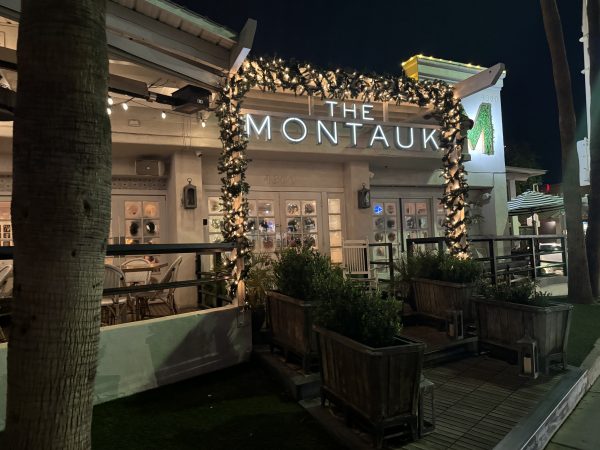
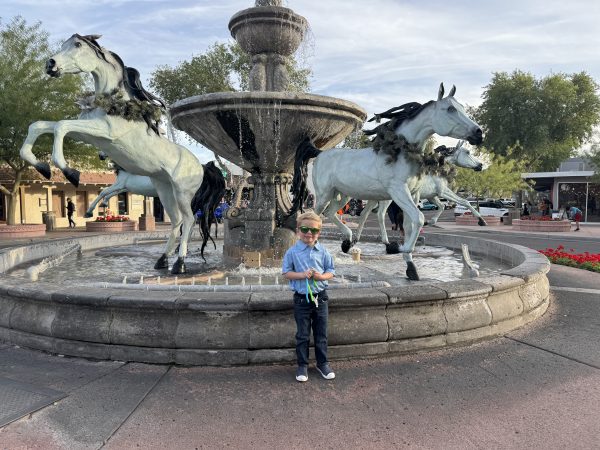
Having been traveling for golf for some time now, people always ask my opinion on my favorite courses or favorite city to go to for a golf trip. My answer always starts with “It depends on who you are going with…”
If you are heading out for a golf trip with your family, I don’t think you can pick a better city than Scottsdale. The travel itself (airport, rental car, etc..) is always a breeze. The resort options (and spas) are plentiful and offer a variety of different setups for couples or kid-friendly atmospheres. And there are hundreds of golf courses to choose from. All the while, Scottsdale has one of the best restaurant and entertainment scenes in the United States.
I’m sure I will keep getting the question. But if you are thinking of a golf trip with the family, the answer is Scottsdale.
If you want help planning your next golf experience or just have any questions about some of mine, reach out to me on Twitter or Instagram and shoot me a message. And feel free to check out my other golf experience articles. I look forward to hearing from you!
- LIKE145
- LEGIT50
- WOW5
- LOL2
- IDHT0
- FLOP3
- OB1
- SHANK5
Courses
PGA Frisco: A GolfWRX first look with Gil Hanse and Beau Welling

PGA Frisco in Frisco, Texas, is the new home of PGA of America. The two courses on-site, Fields Ranch East and West, are original designs by Gil Hanse and Beau Welling, respectfully, but they aren’t set to open for public play until the Spring of 2023. However, GolfWRX was given an opportunity to take an early look, play both courses, tour the facilities, and meet with the course architects ahead of the much-anticipated unveiling for the golf world.
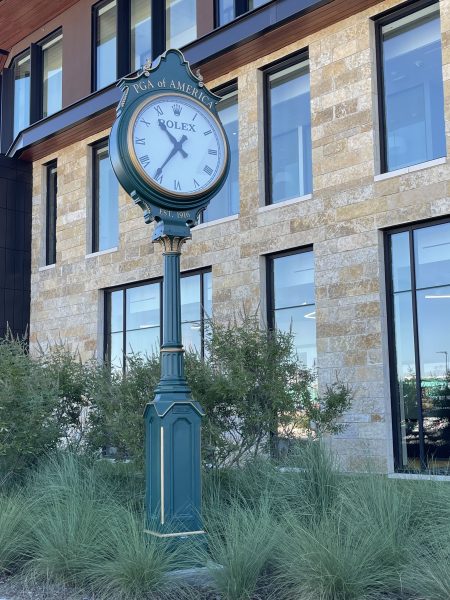
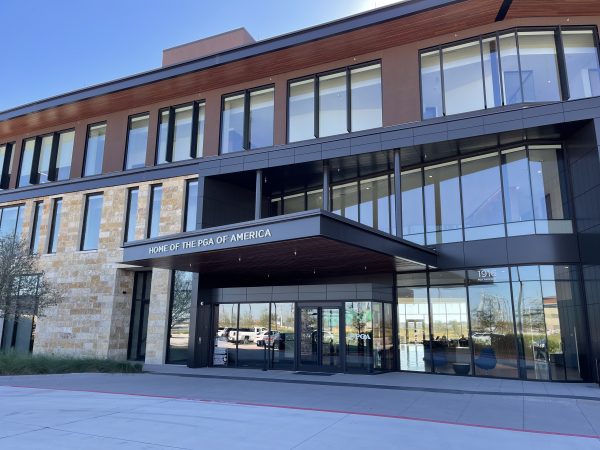
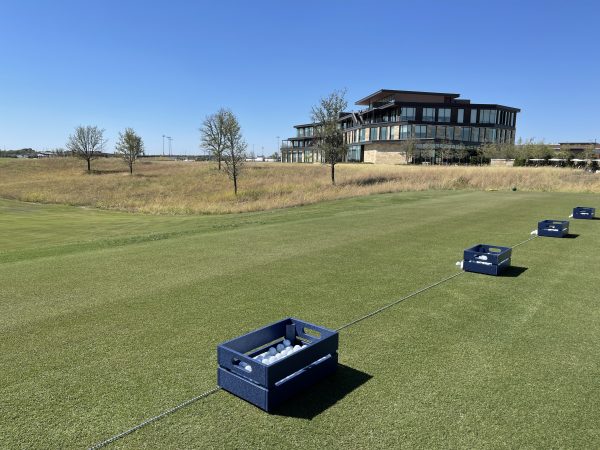
The PGA Frisco location, which also shares the property with a brand new Omni Resort, a short course called The Swing, and a 75,000 square-foot putting course named The Dance Floor, appears to be joining the conversation as one of the country’s best buddy trip and family trip golf destinations.
The Omni resort is going to be complete with 500 luxury guest rooms and suites, 10 private ranch house residences, 13 different dining options, four pools, including an adult-only rooftop infinity pool, and a full-service salon and spa. They are going big with this place. All the facilities are currently under construction, but the plan is for them to be open by the Spring of 2023 as well.
The Swing is a ten-hole, lighted short course that provides a nice nightlife compliment to the larger courses, Fields Ranch East and West. Collaboratively designed by Hanse and Welling, The Swing is just steps from the Omni hotel, The Dance Floor putting course, both championship courses, and a sports bar with bays for hitting into the driving range. The golf isn’t going to stop when the sun goes down. And no shuttle is needed at PGA Frisco.
“With The Swing, we started off by saying you do five holes and we will do five holes but it turned into a true collaboration,” Hanse said when discussing designing the short course alongside Welling. “When you start to think about designing a golf course with the shot values and how is it going to be perceived, what are the players going to think…then that creeps into your design. But when you are designing something just for unbridled joy, you don’t think about those things and that just makes something super fun.”
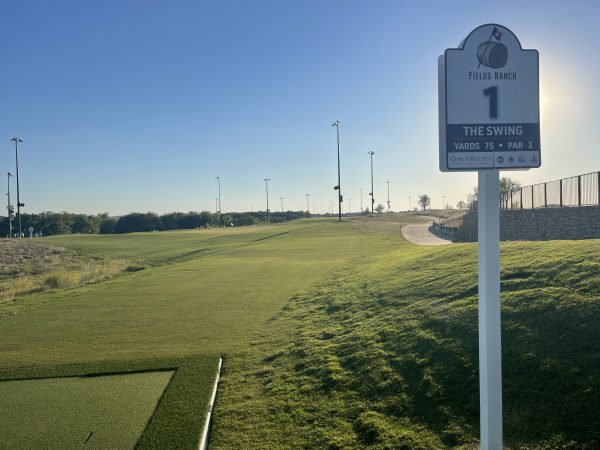
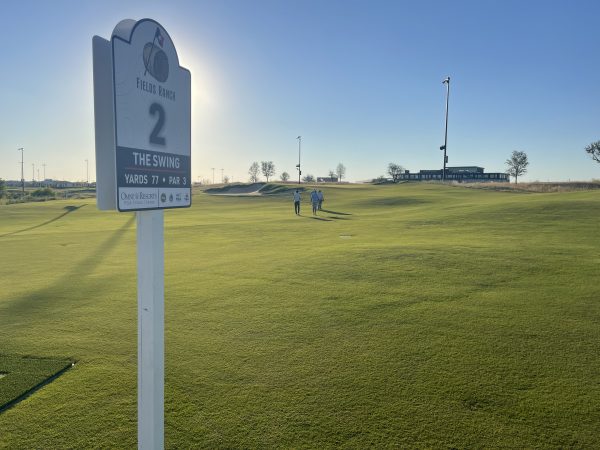
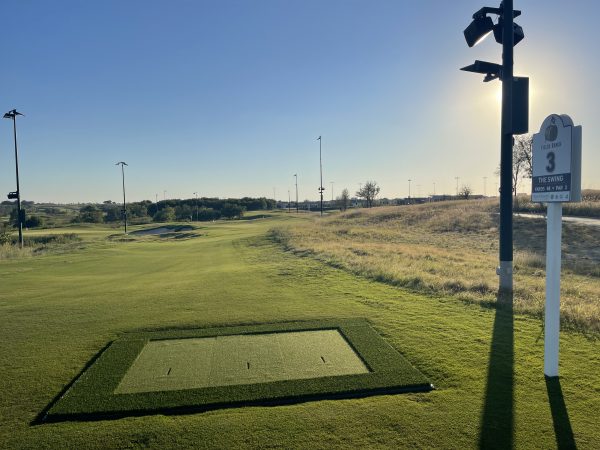
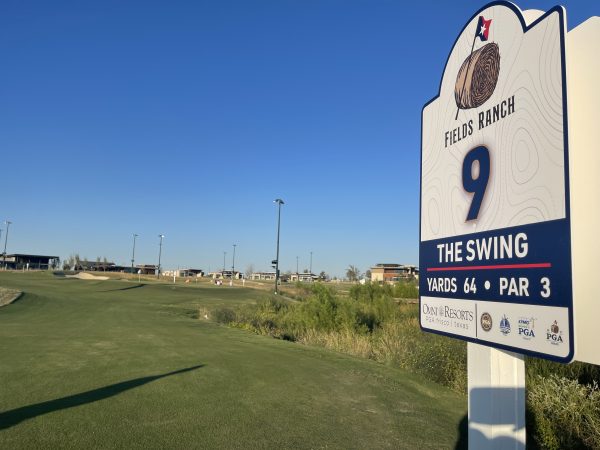
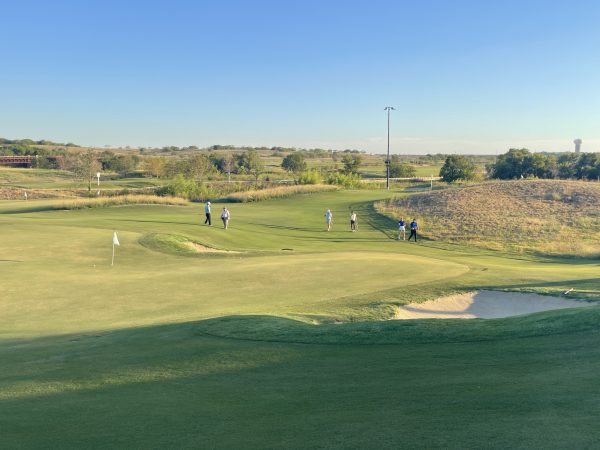
As good as the atmosphere and vibes are going to be, people are going to come for the golf. And major championships are coming too.
Fields Ranch East is already set to host the KitchenAid Senior PGA Championship in 2023, as well as 26 additional championships through 2034, including two PGA Championship events, and the KPMG Women’s PGA Championship.
Fields Ranch West Architect Beau Welling, who is probably best known for his work alongside Tiger Woods on the TGR Design projects, was excited about this property and opportunity right from the very beginning. “The original vision of this idea of multiple golf courses and a short course and practice course and all this fun stuff immediately resonated with me,” Welling said. “I remember thinking that this could be the coolest thing ever. It’s the PGA brand around this super accessible thing where people could not only visit to learn the game but also be the place where major championships are to contend.”
The East Course
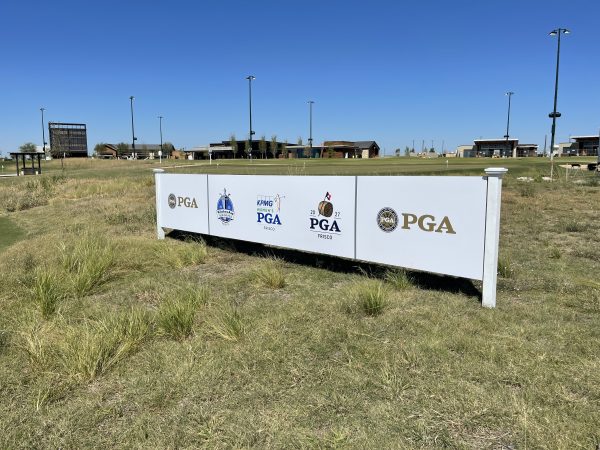
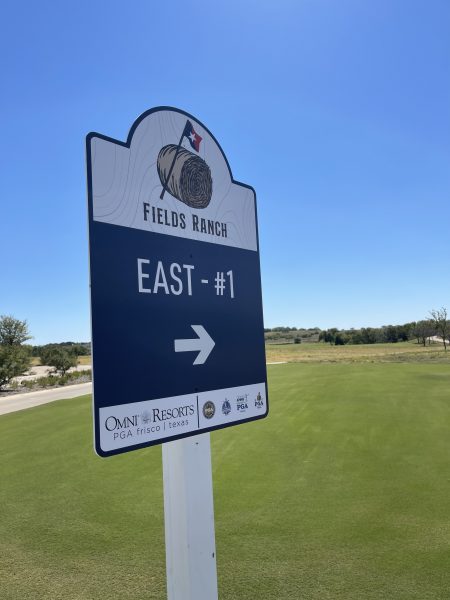
The East course is the Gil Hanse design that is set to host all these majors. The course itself could either play incredibly long or as short as you’d like it, with huge flowing tee boxes being a feature that stands out immediately. Big fairways also immediately reveal themselves as the scale of this course is big. Very big.
“You have to think about how you are going to design for a major championship but also make it approachable and playable,” Hanse said. “We worked really hard to create a playing ground where you can accomplish both. The level of precision required to go out and play the golf course should be pretty low. Wide fairways, hit your ball, find your ball, and hit it again. But the level of precision required to score should be off the charts if we are trying to challenge the best players in the world. There are opportunities to tuck pins and lengthen the East course to 7,800 yards. We feel like we have the setup for a major championship course in place.”
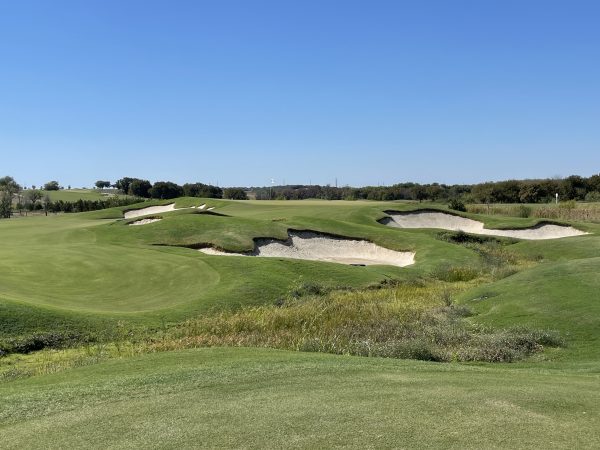
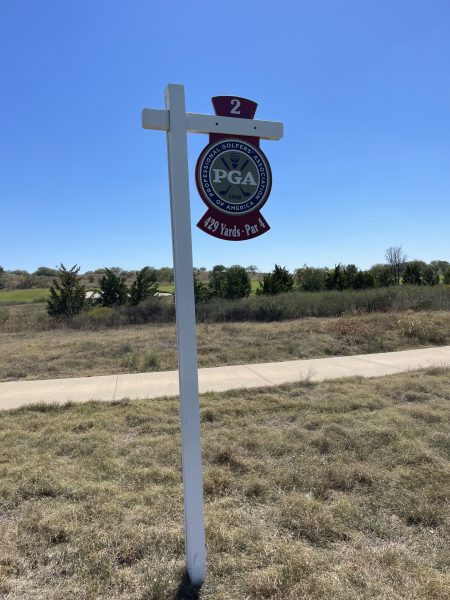
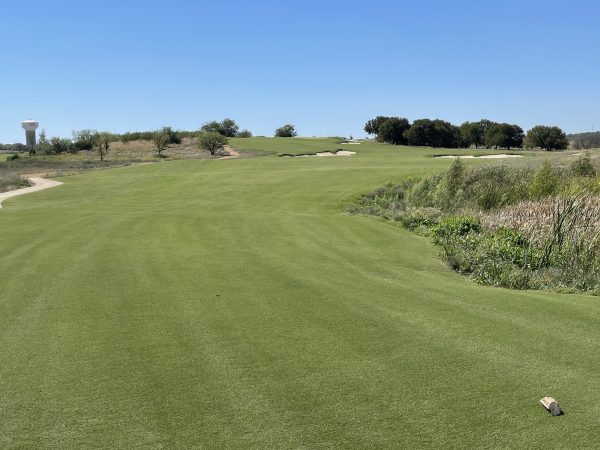
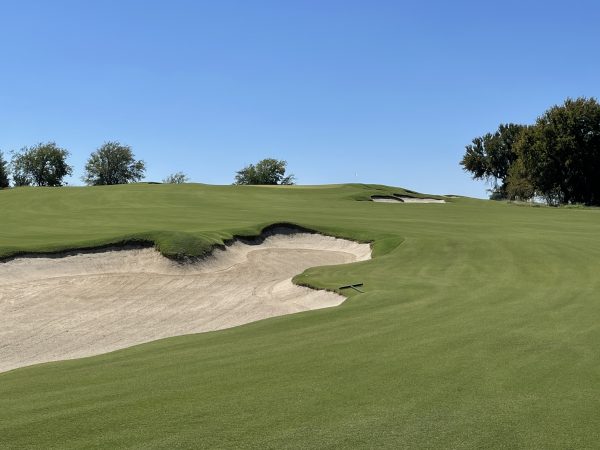
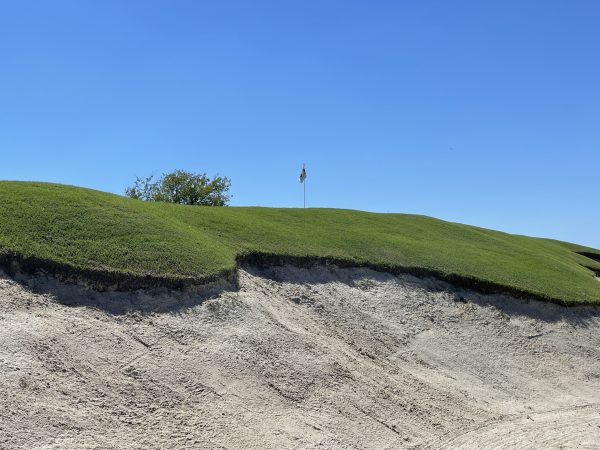
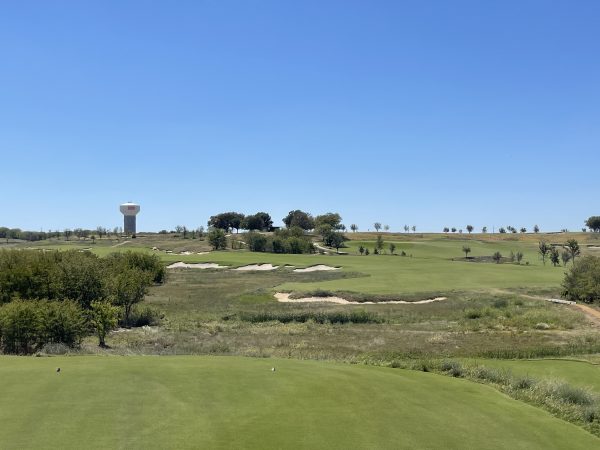
After working on the renovation at Southern Hills, Hanse drew from his experience on the Perry Maxwell design to utilize the site’s meandering Pather Creek and natural dry outs throughout the par 72 track. The course features smallish greens to contrast with the large fairways, making it a second-shot course to put a premium on accurate approaches. The fairways and rough use the same grass type to allow for flexible widening and narrowing of hole corridors to adjust for championship play.
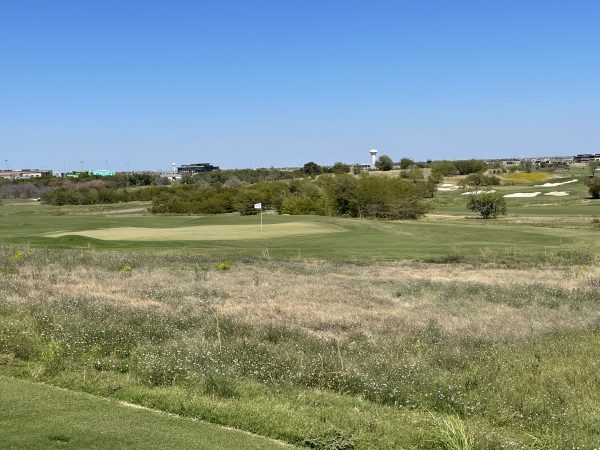
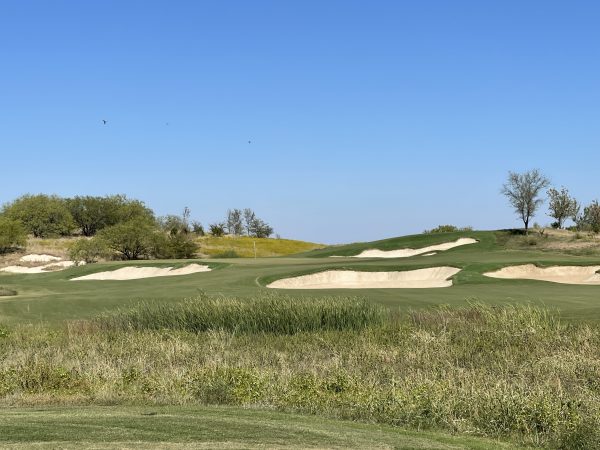
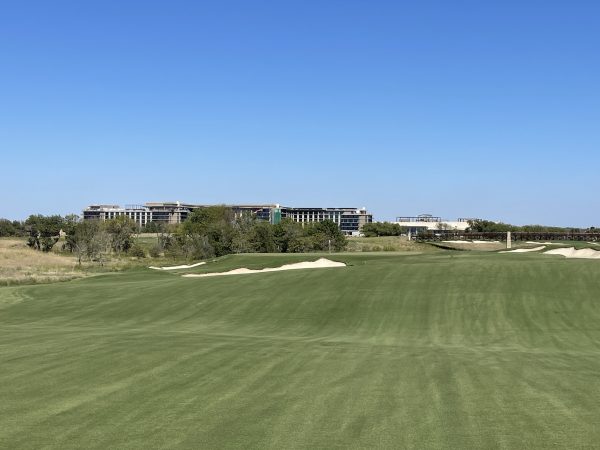
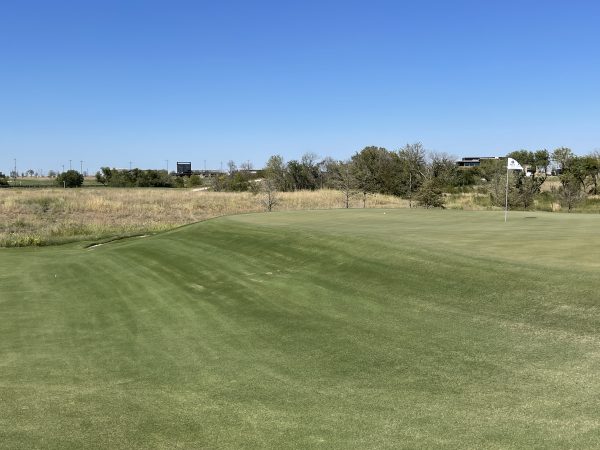
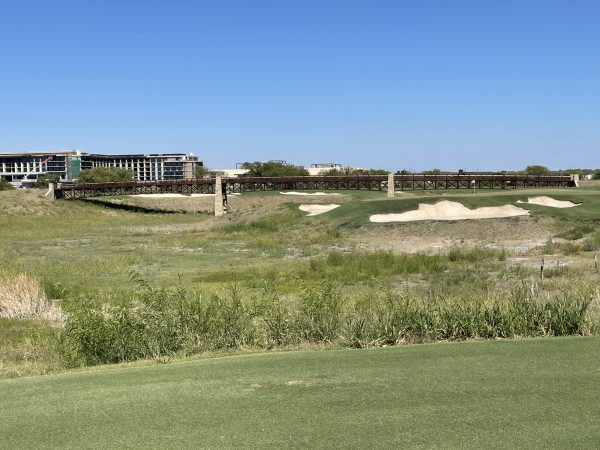
The course maintains a prairie-like feel throughout the routing, but the back nine really shines with Texas character. The creek comes into play on many of the closing holes, including a gorgeously long par three thirteenth hole, and an 18th-hole par five that will hopefully provide some incredible major finishes.
“When the stage is set, we would rather see positive outcomes to determine champions as opposed to negative ones,” Hanse said. “We really enjoy watching golfers make birdies and eagles to win as opposed to some guy making double bogey and the guy who made a bogey barely hangs on to win. So we set up our finishing holes with some tough stretch of holes to start the back nine and then the driveable 15. Then 17 is the shortest par three on the golf course. And then 18 is a reachable par five. So they will have to make decisions and then hopefully positive outcomes will determine how it unfolds.”
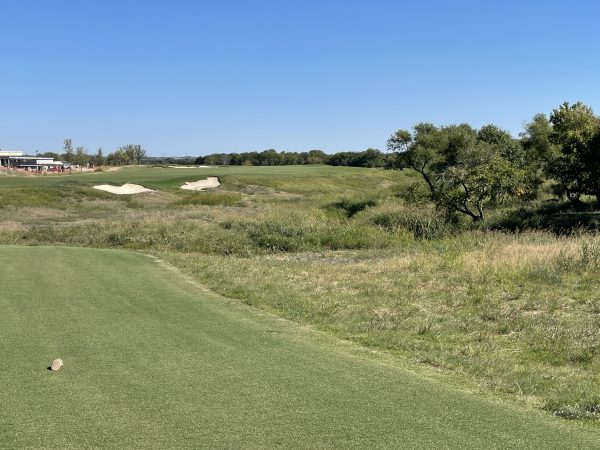
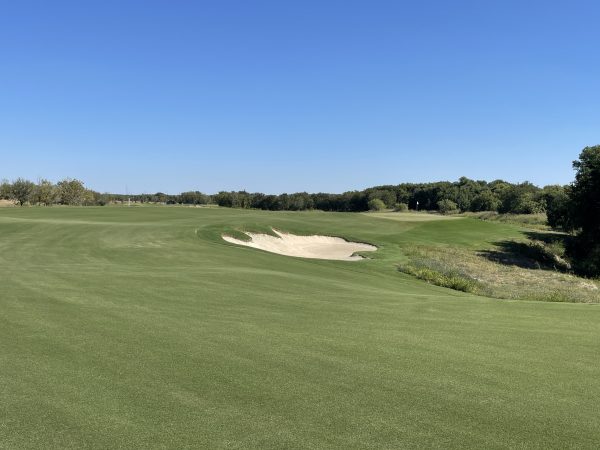
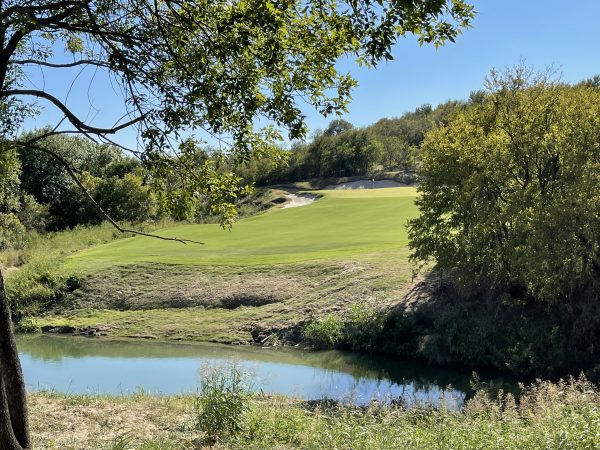
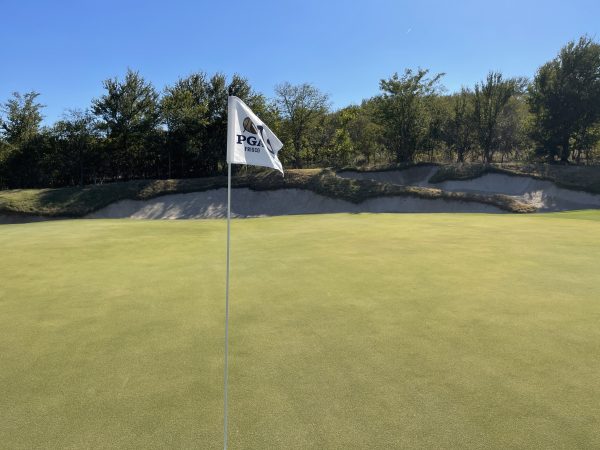
There are also rumors of a Ryder Cup coming to PGA Frisco.
“If we ultimately get the Ryder Cup,” Hanse said, “we thought about most matches not making it to 18. So what can we do with holes 14-16, where generally most matches end. So we wanted to set those up for interesting golf and put it in an amphitheater that is set up really nicely for viewers. So whether it is a PGA championship, LPGA Championship, Senior PGA Championship, or Ryder Cup, we feel like that stretch is going to provide a really interesting way to finish a golf course as opposed to just a long slog to the finish.”
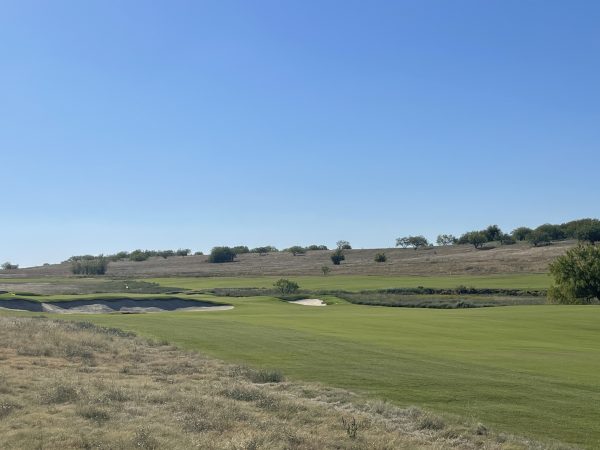

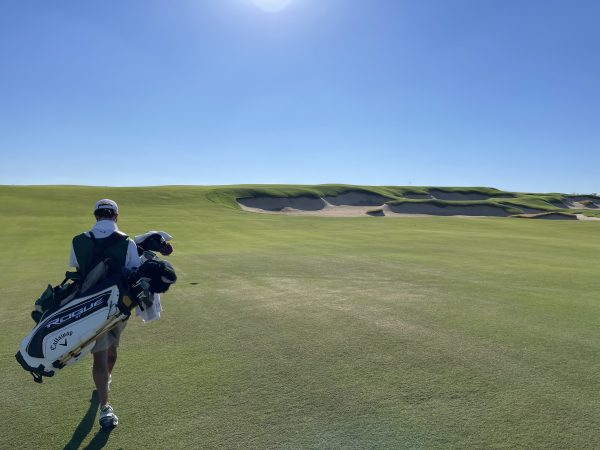
The West Course
The West Course, which is the Welling design, is a playable compliment to the East course, providing another glimpse into big golf in Texas. The expansive fairways average 75 yards in width but the green complexes on Fields Ranch West tend to be much larger than its sister course. The size and scale were both something that Welling wanted to provide as a hat tip to its host state.
“Everything is big in Texas,” Welling said. “There are big weather events and big wind. But there is also incredible passion around the game here in Texas. Frisco is going to get famous because of the major championships on the East golf course, but long term it is going to have such an impact on the game as 28,000 members of the PGA come here to Omni and see golf presented in such a fun and modern way.”
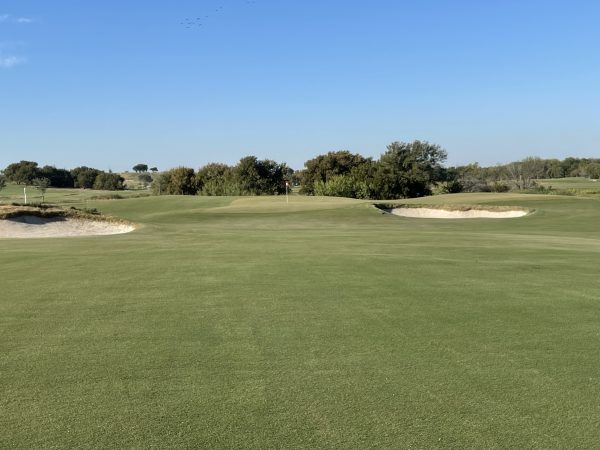
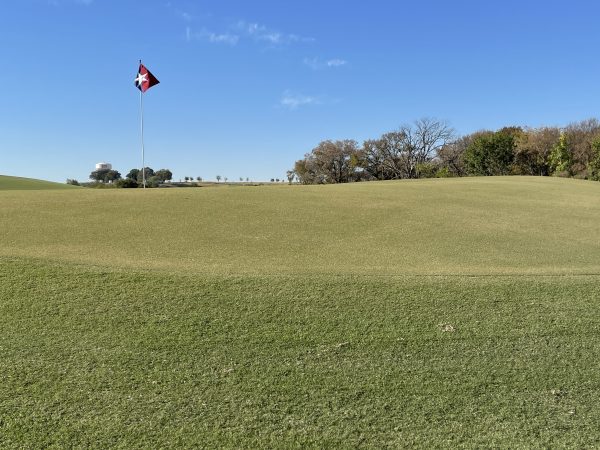
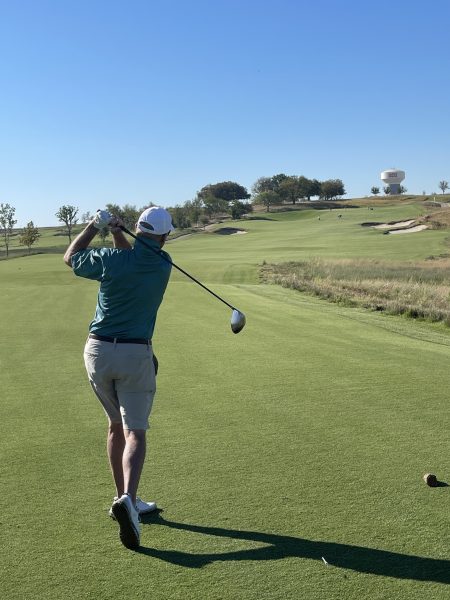
The West Course also plays about 500 yards shorter than the East, tipping out at 7319 yards. The greens are larger but much more complex, with lots of undulation and hills to navigate. While the fairways and greens are big, you need to be in the right spot of each if you want to score. Nearly every green has a false front or false side waiting to shoot an errant approach back down the hillside.
Still, the scale allows for any handicapped golfer to play this course with enjoyment.
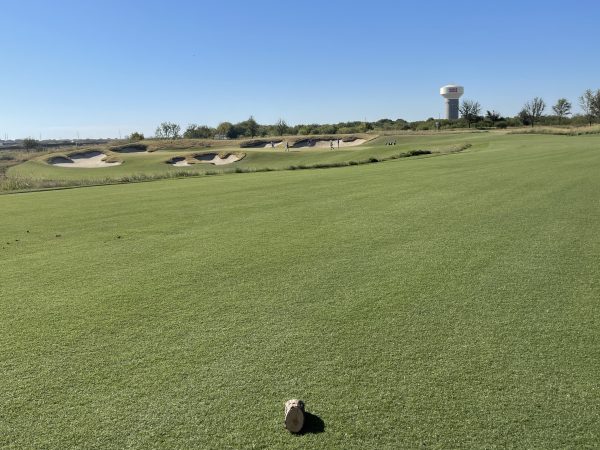
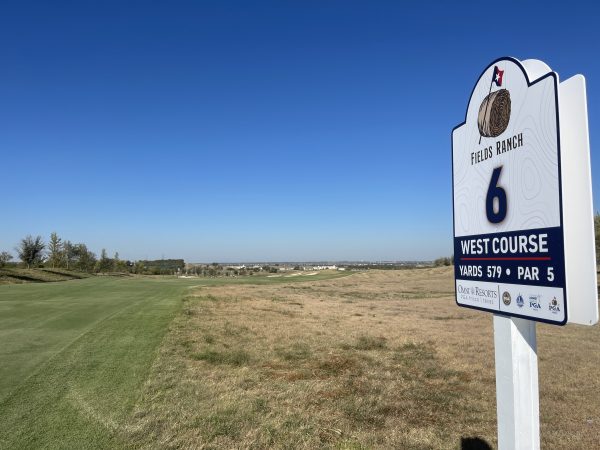
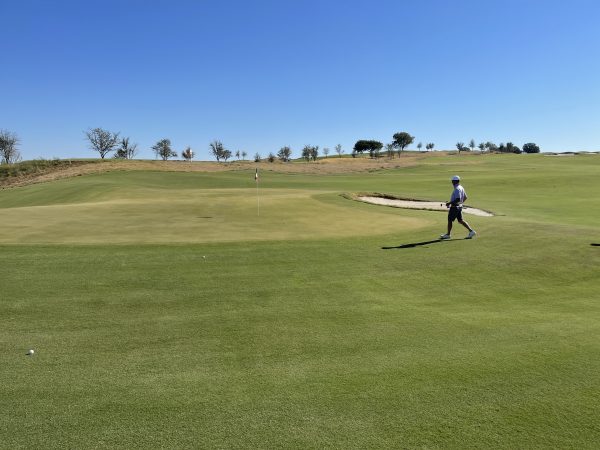
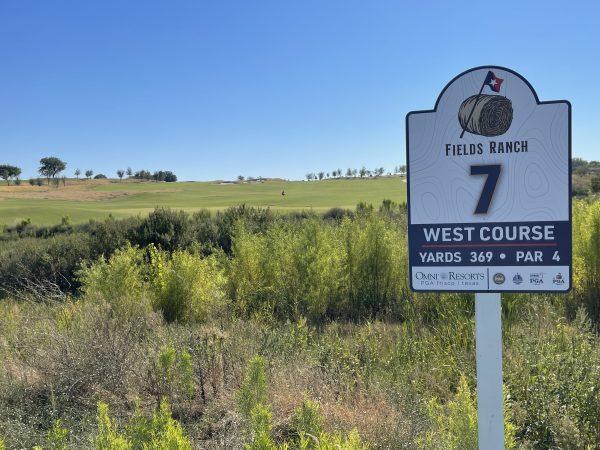
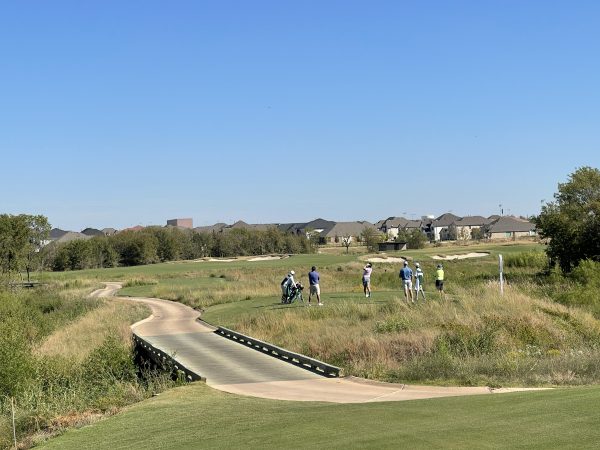
The course also uses the local terrain and elevation changes to both challenge and support each hole. The shorter par 4’s are often uphill, adding length where it isn’t otherwise there. The marshland and Panther Creek are more prevalent on the West course as well, utilizing the hazard to create more necessary carries.
The end result for Fields Ranch West is an approachable compliment to its companion course. There is an obvious feeling of connection between the two courses, but the style of play required for each is unique.
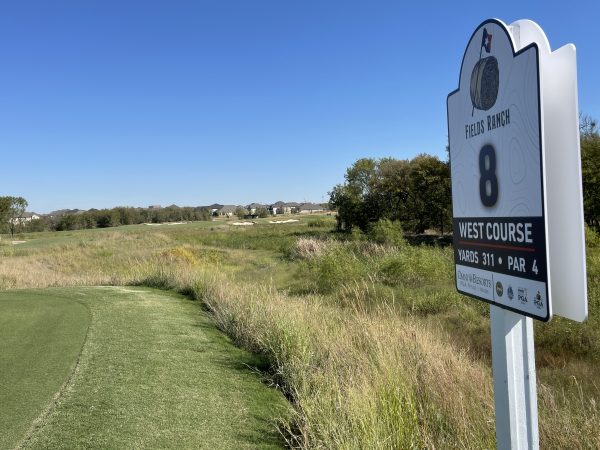
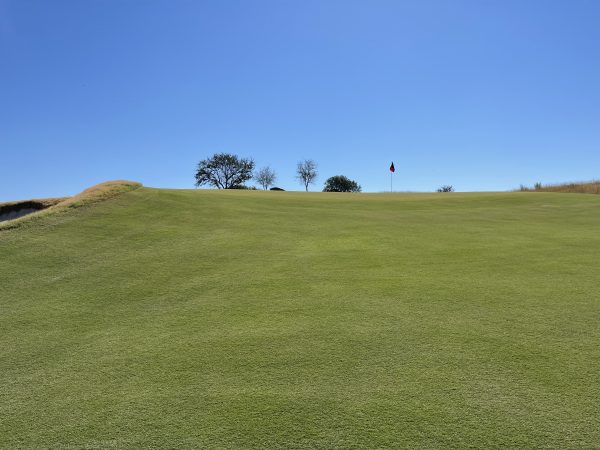
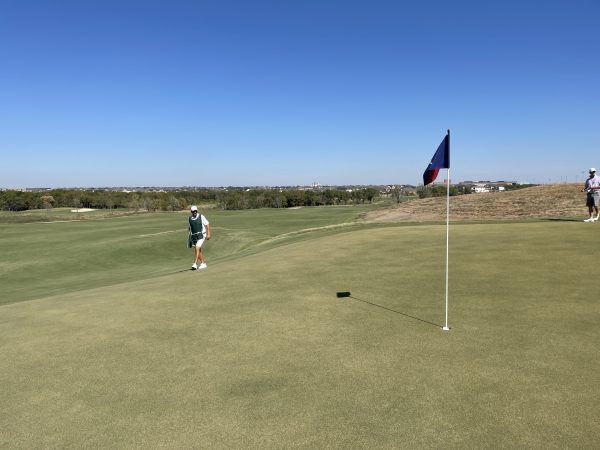
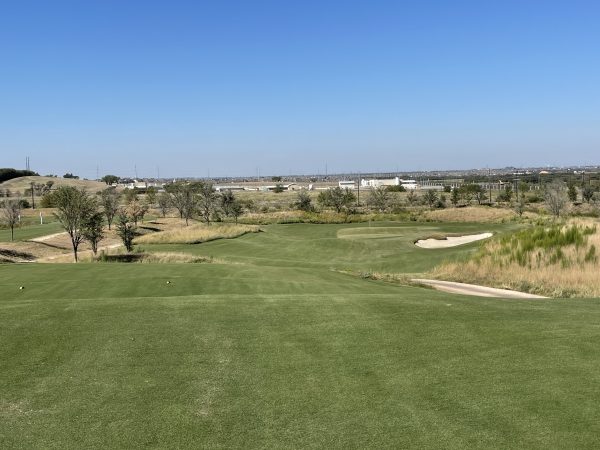

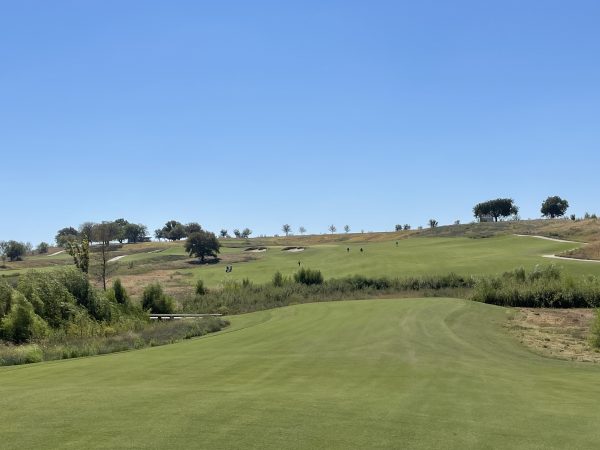
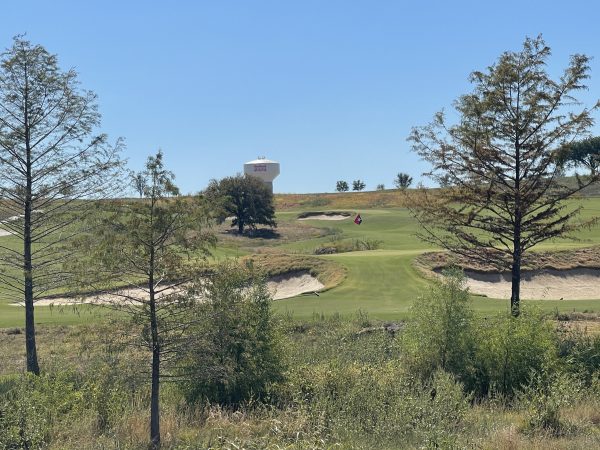
With the partnership and resources of the PGA of America and Omni Hotels and the design leadership of Gil Hanse and Beau Welling, the PGA Frisco campus is primed to rival the best in the world as a premier golf destination.
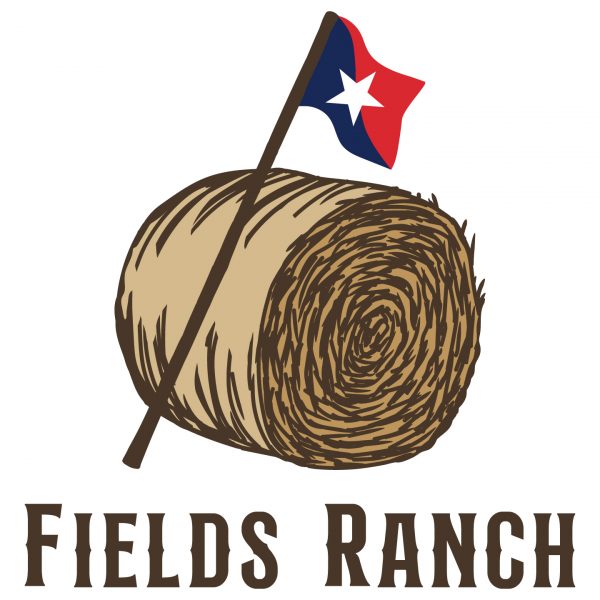
- LIKE60
- LEGIT38
- WOW18
- LOL0
- IDHT2
- FLOP0
- OB0
- SHANK0
Courses
Inside Pebble Beach’s “The Hay” Short Course (designed by Tiger Woods/TGR)
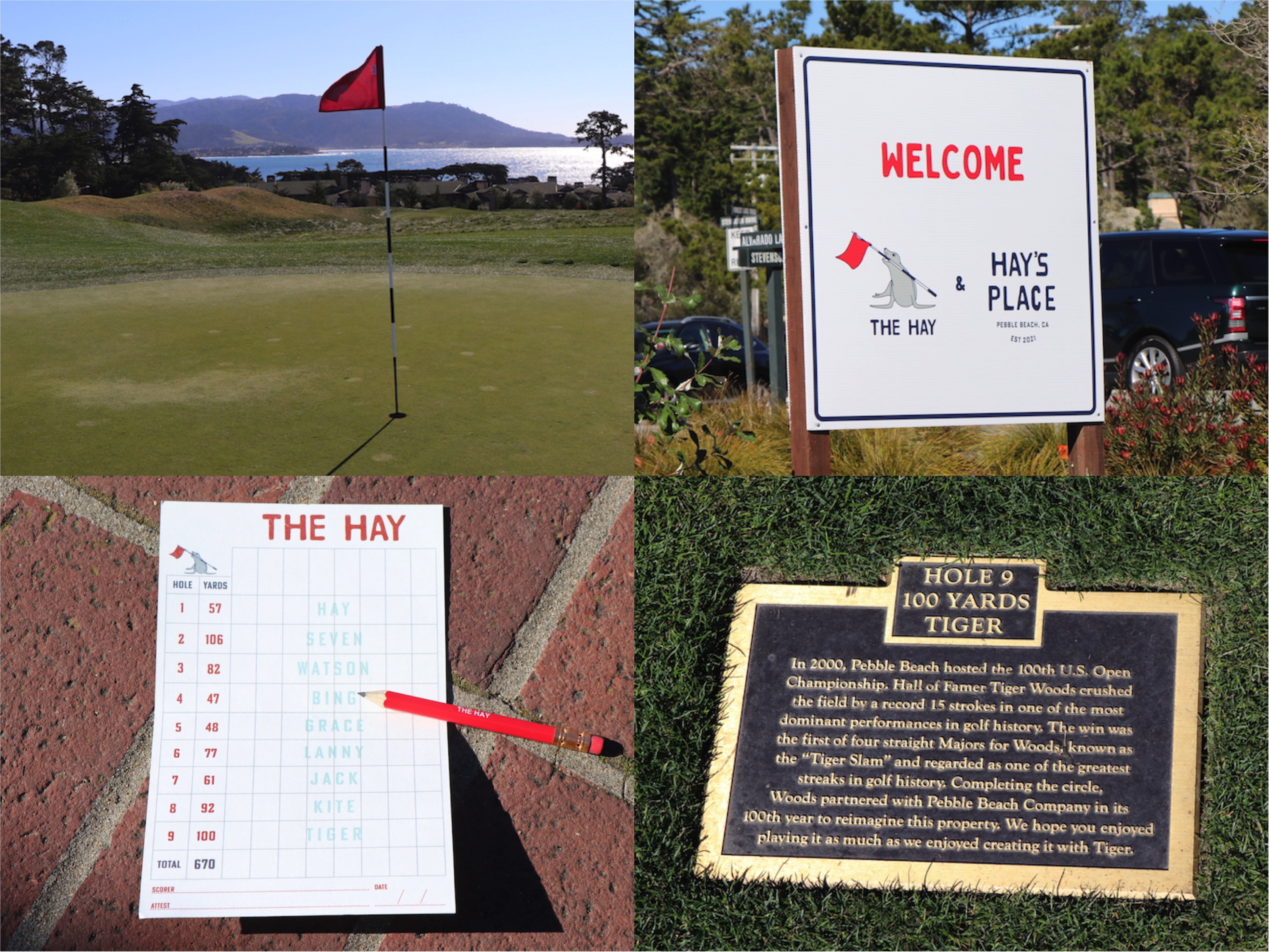
This is my first trip to Pebble Beach since Tiger Woods’ new “The Hay” short course opened up in 2021, so I had to see the new setup for myself. Preferably, I would have actually played it, but the course was closed for maintenance ahead of the 2022 AT&T Pebble Beach Pro-Am festivities.
Luckily, though, I had my camera handy as the fine folks at Pebble Beach’s short course allowed me to walk around and check it out. Below, I’ll take you along my walking tour, but first, some brief backstory and information.
The short course, formerly known as the Peter Hay Golf Course, sits just across the road from Pebble Beach’s driving range, and it’s been a fixture at the resort since 1957. The course was originally named after Peter Hay, the head professional at Pebble Beach and Del Monte. He created the short course to provide a way for junior golfers and families to more easily access the game, regardless of their abilities.
In 2021, Pebble Beach teamed up with Tiger Woods and the TGR Design team to give the course a redesign (without moving any trees or dirt, according to a Pebble Beach representative).

The new 9-hole short course is open to the general public for $65, and juniors under 12 years old play for free. The putting course, which sprawls about 100 yards in length, is open to the public at no cost, as well.
“We know not everyone who comes to Pebble Beach will have a chance to play the U.S. Open course, so we wanted to create the opportunity for all visitors to experience one of its most famous holes,” said Tiger Woods, according to The Hay’s website.
There’s also a restaurant/bar – called “Hay’s Place” – that has views of the entire course, and of Stillwater Cove. It’s not a bad spot to grab a drink before or after the round, and I hear the fish tacos are phenomenal. Just saying.
Enjoy the photos below from Tiger’s new-and-improved Pebble Beach Short Course, called “The Hay.”
The 100-yard putting green course




Hole No. 1: “Hay”





Hole No. 2: “Seven”




Hole No. 3: “Watson”




Hole No. 4: “Bing”




Hole No. 5: “Grace”




Hole No. 6: “Lanny”





Hole No. 7: “Jack”



Hole No. 8: “Kite”






Hole No. 9: “Tiger”






Hay’s Place



Check out more photos from the 2022 AT&T Pebble Beach Pro-Am here.
- LIKE33
- LEGIT7
- WOW4
- LOL0
- IDHT0
- FLOP0
- OB0
- SHANK5
-

 19th Hole2 weeks ago
19th Hole2 weeks agoDave Portnoy places monstrous outright bet for the 2024 Masters
-

 19th Hole4 days ago
19th Hole4 days agoJustin Thomas on the equipment choice of Scottie Scheffler that he thinks is ‘weird’
-

 19th Hole2 weeks ago
19th Hole2 weeks agoTiger Woods arrives at 2024 Masters equipped with a putter that may surprise you
-

 19th Hole4 days ago
19th Hole4 days ago‘Absolutely crazy’ – Major champ lays into Patrick Cantlay over his decision on final hole of RBC Heritage
-

 19th Hole2 weeks ago
19th Hole2 weeks agoTwo star names reportedly blanked Jon Rahm all week at the Masters
-

 19th Hole1 week ago
19th Hole1 week agoReport: LIV Golf identifies latest star name they hope to sign to breakaway tour
-

 19th Hole2 weeks ago
19th Hole2 weeks agoNeal Shipley presser ends in awkward fashion after reporter claims Tiger handed him note on 8th fairway
-

 19th Hole1 week ago
19th Hole1 week agoBrandel Chamblee has ‘no doubt’ who started the McIlroy/LIV rumor and why















